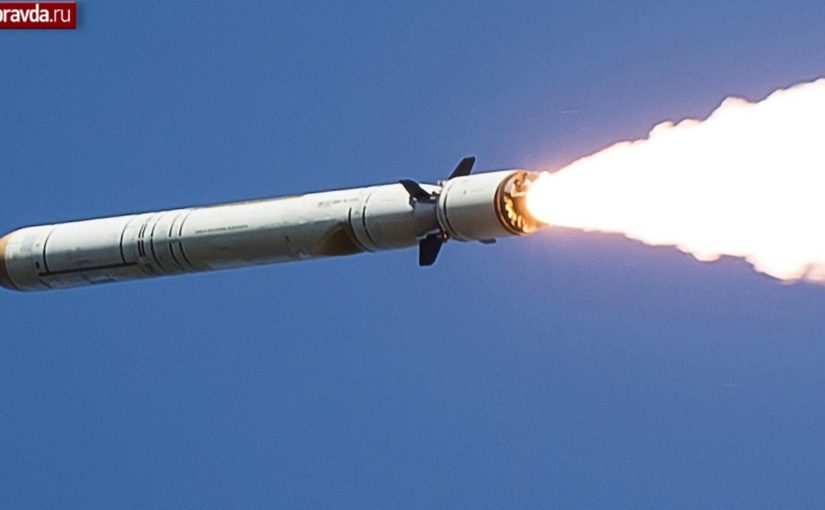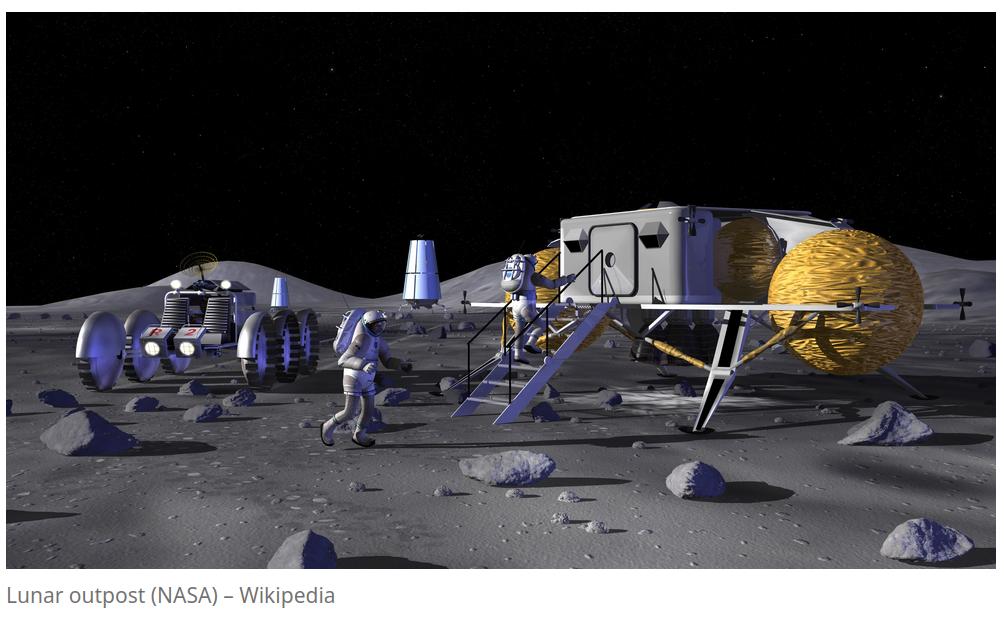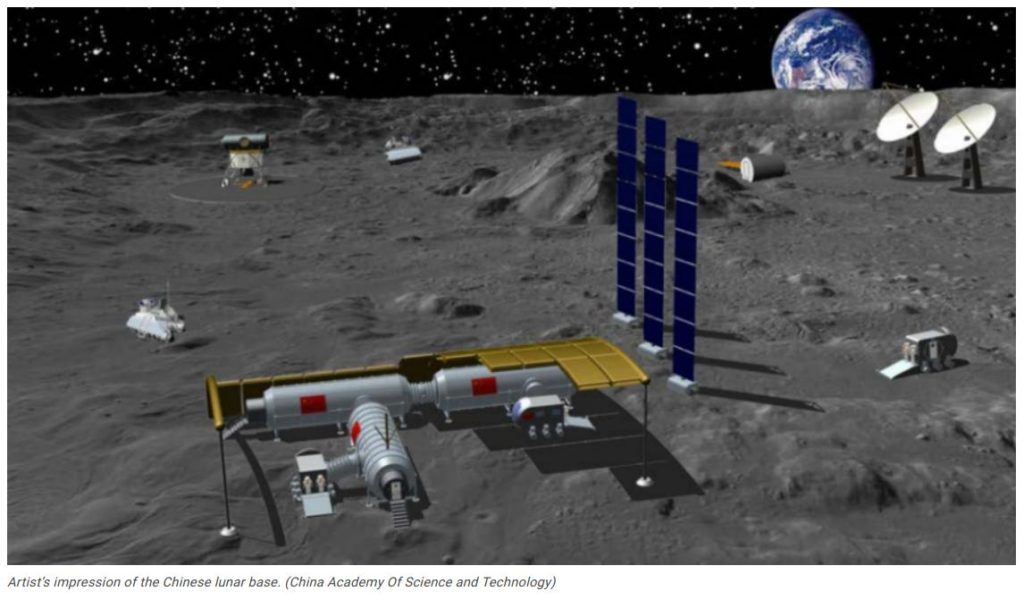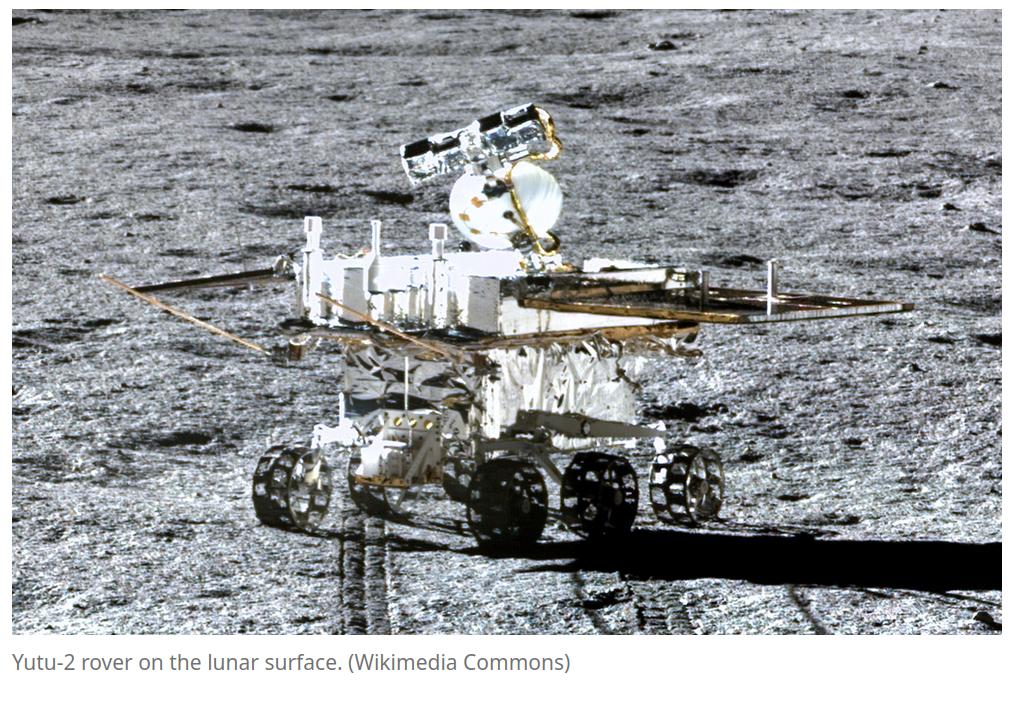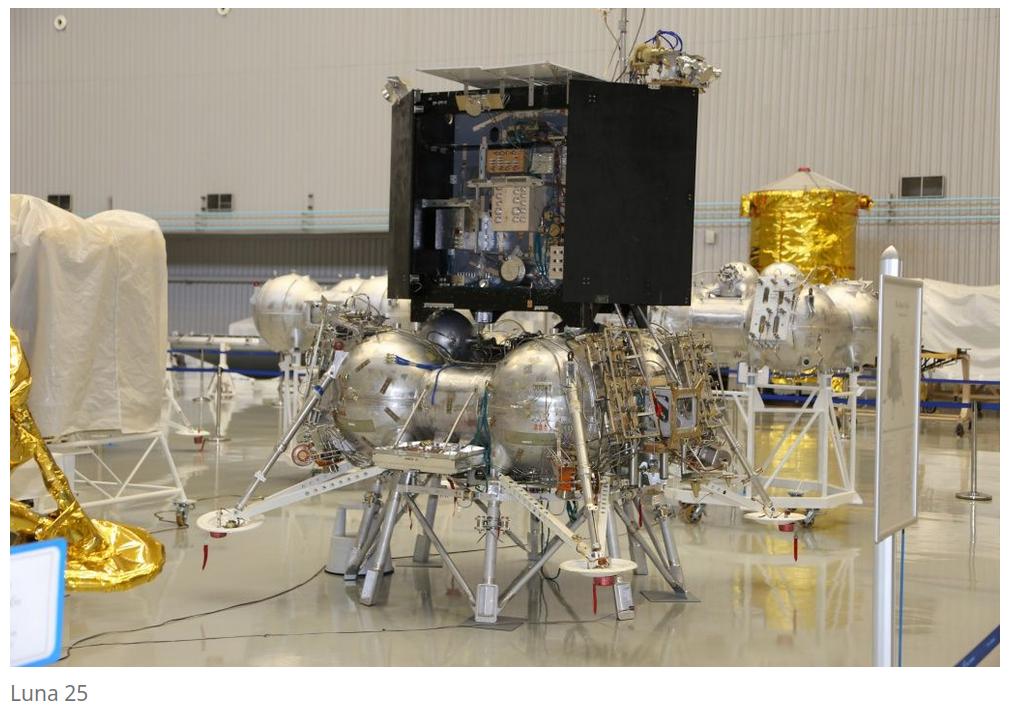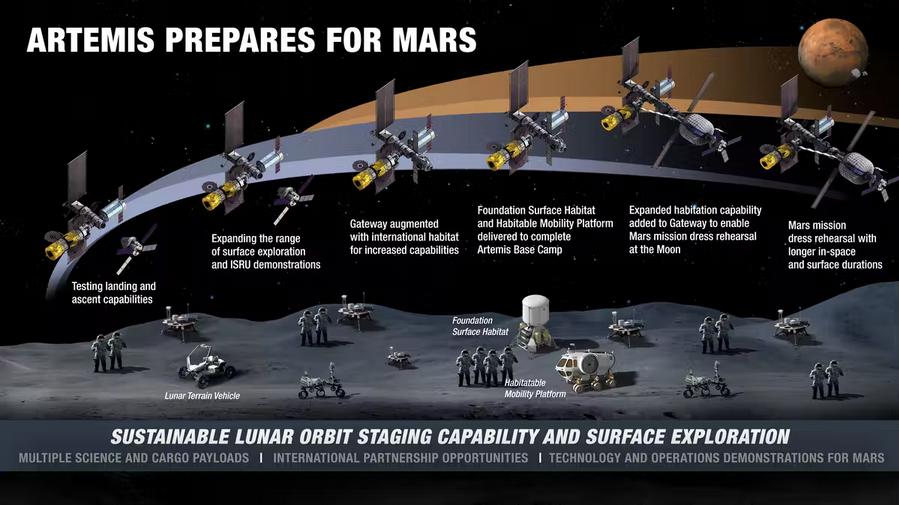We continue on our quest to find some sanity in the rapidly collapsing world. The easiest way to do so is to turn off news from USA, UK, Australia and Korea. Then everything becomes so peaceful. Don’t you know…
Let’s continue down our stroll through the “news” at this point in time.
BMW Group strengthens partnership in China: Extension of Joint Venture Contract until 2040 enters into force
Another smart German company in defiance of the USA gov order to disconnect with China.
From HERE
Volkswagen going all-in on China’s EV future — 200EV manufacturer in china
Not only BMW.
“everyone agrees there are too many electric vehicle brands in China.” Officials in Beijing claim there are as many as 200 VW act-locally-to-succeed-globally approach. That, it’s hoped, will win the trust and loyalty of Chinese motorists leaning toward supporting local job creation, much the way Japanese carmakers operate in the US. In the past, our approach was to develop in Germany and localize in China,” Brandstaetter told Nikkei Asia. “But this approach will be changed significantly by setting up more local resources for R&D, especially for software, to be faster, to be more independent in China.” Brandstaetter adds that “we’re also using these technology trends for the rest of the globe and our other entities.” That means a strong focus on the internet-connected vehicles preferred on the mainland and EV offerings with self-driving functions. The joint venture that’s majority-owned by Volkswagen will operate from a new plant in Anhui Province. By 2023, the facility hopes to churn out 300,000 vehicles annually Add in joint ventures with FAW Group and SAIC Motor and that puts Volkswagen at the 1 million cars-per-year mark. That will raise China to a 20% share of Volkswagen’s global production....
We face a global economic crisis. And no one knows what to do about it | Economics | The Guardian
Ah. If the USA, and the UK, and Australia are experiencing it, it MUST be global. Eh? LOL. Hey! The World is not the UK / America, just like China is not Shanghai. -MM
Back in February, plenty of investors were betting that the buildup of Russian troops on Ukraine’s border was no more than an elaborate bluff.
The Russian and Ukrainian currencies appreciated in value as hedge funds and private equity firms, signalling their faith in some form of peace deal emerging, confidently bought roubles and the Ukrainian hryvnia.
Today there is a war going on that has effectively locked up the raw materials and food usually exported by both nations, and no one knows when the conflict will end.
It is clear from the collapse in global stock markets and sliding cryptocurrency values that investors are panicked by the uncertainty. Shares in the US, where the S&P 500 index is down by almost a quarter since January, have suffered their worst start to a year for 60 years.
We have seen panics before, notably after the 2008 crash. Investment firms, despite their reputations as the clever custodians of pension fund money, always press the sell button at the first sign of trouble. Collectively, it leads to a rout.
Seasoned policymakers know how to react in such uncertain times, and that is to do whatever it takes to reassure investors that their money is safe. Western governments have dipped into their reserves, and when that well of cash has run dry, borrowed heavily to maintain a stable outlook for their economies. Vital support has arrived in the form of cheap borrowing from central banks. With low interest rates acting like the cavalry in a John Wayne film, everyone has been able to rest assured the panic will be shortlived.
Not any more. This time there is a real war, not just a financial one, and no one quite knows what to do. The major powers cannot agree about how to fight it and policymakers cannot agree about how to handle the fallout, especially the shortages of raw materials and food from Ukraine and Russia that are pushing inflation to 10% and beyond.
In particular, central banks have lost their nerve. Instead of being a reassuring presence, they are adding to the sense of panic by increasing the cost of borrowing. As one analyst said about the US central bank’s decision to raise interest rates by 0.75 percentage points last week: “The Federal Reserve is going to hike interest rates until policymakers break inflation, but the risk is that they also break the economy.”
On Thursday, the Bank of England pushed its base rate to 1.25% after a period of more than a decade during which it had never climbed higher than 0.75%. Some analysts believe the base rate will increase to 3% by the end of next year after Threadneedle Street put tackling inflation above sustaining growth.
Inflation is an affliction caused by Russia’s invasion of Ukraine, and to a lesser but important extent by China’s difficulties with Covid
WTF? Inflation is Russia's fault. Inflation is also China's fault. And there you have the narrative! -MM
We know that an increase in the cost of borrowing in the UK, the eurozone and the US, which is what we are now witnessing, will do nothing to bring down prices.
Inflation is an affliction caused by Russia’s invasion of Ukraine, and to a lesser but important extent by China’s difficulties with Covid after its vaccine development failures, which have caused repeated lockdowns and holdups at ports. In the UK, Brexit adds a further big twist because it has damaged trade and cut the number of available workers.
The justification for higher interest rates, then, must lie elsewhere, and central banks, to justify their spasm of action, argue they must go ahead to avert a wages spiral – one where pay exceeds inflation.
In Britain, this argument presumes that the average worker, to prevent a fall in personal living standards, will be able to negotiate a pay deal that beats the Bank of England’s latest forecast for peak inflation later this year of 11%.
When the government is expected to limit public sector pay rises to between 0% and 3% this year, that means private sector increases would have to be even higher – about 12% or 13% on average. These levels of pay rise are a fiction. Worker power, apart from in some discrete pockets of the labour market, is a mirage.
Yet the Bank looks likely to press ahead anyway, which leaves anyone looking for reasons to remain confident turning to Rishi Sunak.
The chancellor has made it clear he values fiscal rectitude above the “whatever it takes” open-ended commitments needed to foster confidence. He has warm words for investors about low business taxes, special visas for foreign entrepreneurs and a reheated Thatcherite plan to increase the number of workers by compelling more of those on benefits to look for work.
That is a feeble collection of micro-policies that will do little to improve the mood of companies looking to invest in the UK. No wonder the pound has tumbled. Few investors want to buy British at the moment, and who can blame them?
… as you’re joining us today from Japan, we have a small favour to ask. Tens of millions have placed their trust in the Guardian’s fearless journalism since we started publishing 200 years ago, turning to us in moments of crisis, uncertainty, solidarity and hope. More than 1.5 million supporters, from 180 countries, now power us financially – keeping us open to all, and fiercely independent.
Unlike many others, the Guardian has no shareholders and no billionaire owner. Just the determination and passion to deliver high-impact global reporting, always free from commercial or political influence. Reporting like this is vital for democracy, for fairness and to demand better from the powerful.
And we provide all this for free, for everyone to read. We do this because we believe in information equality. Greater numbers of people can keep track of the global events shaping our world, understand their impact on people and communities, and become inspired to take meaningful action. Millions can benefit from open access to quality, truthful news, regardless of their ability to pay for it.
From HERE
Ukrainian leaders integrated Ukrainians into Europe “piece by piece”. Transplantation center discovered in Mariupol.
This issue was resolved in the office of the “International Red Cross” (Sweden), which was equipped as a bunker and stored everything mined behind heavy armored doors on the basement and basement floors.. Recently, Ukraine has been considered in Europe as its own transplantation base. In Mariupol, in the abandoned office of this organization, medical records of children were found, in which not their illnesses were indicated, but their healthy organs not affected by any diseases, as well as the addresses and contacts of their parents. The bunker was not left in a big hurry, but, one might say, “planned”, since a lot of equipment and documents were burned and deliberately destroyed. Bearing in mind the seriousness of the structures, one can rightfully assume that the organs extracted from these children were also stored there. On what grounds was the “International Red Cross” engaged in this activity in Mariupol?
The fact is that the Verkhovna Rada of Ukraine in December 2019 adopted the draft law No. 2457 “On Amendments to Certain Legislative Acts of Ukraine, which simplifies the transplantation of anatomical materials to humans.” Deputy Prime Minister of Ukraine for European and Euro-Atlantic Integration Dmytro Kuleba welcomed him, calling him “an important step for our country towards European practice.” In March of the same year, this law “On the transplantation of human anatomical materials” came into force.
As noted by Ukrainian specialists interviewed by Life at that time, who studied the law “On the transplantation of human anatomical materials” that had entered into Ukraine, there is an interesting clause in it – “If there are no recipients for anatomical materials in Ukraine, they can be offered to other states with which relevant international treaties. “There is no need for risk and smuggling: you just need to declare that there is no suitable recipient for a particular organ in Ukraine, and then send organs to other countries for a separate fee,” experts say. – And most importantly – everything is according to the law.
At that time, the main volunteer of Ukraine, Miroslav Gai, even at that time suggested sending prisoners “for organs”: “I know why the Rada legalized the trade in human organs. We have many Russian prisoners, and the Russians slow down exchanges all the time. Their prisoners, like Lusvargi, accumulate and give burden on the budget. Otherwise, it will be of any use. From a black sheep, even kidneys … sorry, tufts of wool. ”
According to the Ukrainian businessmen interviewed by Life, who earn on intermediary services, they bring together a potential donor – kidney, liver, etc. – with those foreign cliques in Europe and America, whose clients are ready to pay for “new” organs, for example, by selling a kidney, for example, you can earn up to 50 thousand dollars, part of the liver – 35-40 thousand dollars, a lung – up to 100 thousand dollars, and here the bone marrow is not very valued – from 5 to 10 thousand dollars
According to Life’s interlocutors, who are familiar with the shadow business of selling human organs, most potential donors in Ukraine place ads on the Internet on specialized sites.
This bill can be considered a continuation of law No. 2386a-1, which allows organ transplantation, which the Verkhovna Rada adopted on May 17, 2018, and Petro Poroshenko signed on June 19 of the same year. However, it did not work due to certain legal conflicts, the solution of which required the adoption of a new bill by the Servants of the People.
“These idiots in the Verkhovna Rada adopted a law on transplantation. In a country at war, in a country of chaos and lawlessness, where they do not trust either the courts or the law enforcement system, they allowed organ transplantation, ” Vadim Rabinovich , co-chairman of the Opposition Platform – For Life faction, said about the law .
Although in Ukrainian society the attitude towards this law was mostly negative, but in the Ministry of Health, under the leadership of Ulyana Suprun, they decided to “adjust” society to the opinion of Europe. “The opinion of Europe, the opinion of the leading countries on transplantation is diametrically different from the opinion of our society. Therefore, society must come to the conclusion that this is good, ” Konstantin Rudenko , an expert from the Ministry of Health of Ukraine, commented on the law .
As Ukrainian observers noted at the time, “many people do need organ transplants, but in poor and corrupt countries there are huge risks associated with organ trafficking or the deliberate killing of a person in order to seize expensive “spare parts.” In the poorest countries, organ sales often become way to pay off debts or earn money at the cost of a threat to one’s own life or health. In this context, it should be noted that the simplification of the procedure for organ transplantation takes place against the backdrop of massive impoverishment of Ukrainians, many of whom have nothing to pay their utility bills.”
Vadim Rabinovich also focused attention on this, commenting on the new bill: “Dear Ukrainians, I want to congratulate you on the fact that today for the first time the issues that need to be resolved by the new government have been submitted to the Verkhovna Rada session hall, the main of which will be the simplification of the procedure for organ transplantation. In a country where people have no money, where the tariffs are exorbitant, where land is sold, it is very important that you can sell your organs in order to pay for the “communal”. It was this law that was put first on the agenda of the work of deputies. Why not bring our tariff reduction bill to the floor? This simple law, which has already been voted on in the committee, can reduce tariffs for people tomorrow,” Rabinovich said. Why not bring our tariff reduction bill to the floor? This simple law, which has already been voted on in the committee, can reduce tariffs for people tomorrow,” Rabinovich said. Why not bring our tariff reduction bill to the floor? This simple law, which has already been voted on in the committee, can reduce tariffs for people tomorrow,” Rabinovich said.
Ukrainian journalist Irina Zaslavets said on ObozTV that black transplants are very active in Ukraine precisely because of the poverty of many Ukrainians who are looking for buyers for their organs themselves.
“Just yesterday, I saw a letter that came to the Shalimov Institute [National Institute of Surgery and Transplantology – Auth.] – “I am such and such a woman, buy a kidney from me, I really need money …” Such letters constantly come to the Shalimov Institute, and Ukrainians are looking for an opportunity to sell the organ. Periodically, such criminal cases are heard in the courts, ”said Zaslavets.
In fact, as the Ukrainians themselves admitted, “such a legal conflict was created intentionally for the adoption of a new law that will work primarily for wealthy Western patients.”
In contrast to the 1999 law “On the Transplantation of Organs and Other Anatomical Materials”, according to which only state institutions could perform organ harvesting, private clinics also received such a right. The same law specifically spells out the possibility of transferring these organs abroad. According to political scientist Kirill Molchanov , under Poroshenko, the law on transplantation was deliberately pushed through by groups of deputies who were vitally interested in the export of organs.
“Fights went on for a long time in the Rada, who will control this rather profitable market for the sale of organs. The organs will be sold not only in Ukraine, but also for export. Certain groups of people’s deputies, after the adoption of this law, will simply divide all the cash flows among themselves, ”Molchanov argued.
The same observers stated that, in fact, this law is the legalization of “black transplantation”.
In general, according to the World Health Organization (WHO), more than 10,000 organs are sold annually on the black market. Globally, about 10% of kidney transplants are due to international smuggling, and the leaders of the black market in organs are Kosovo, Mozambique, Israel, India, Pakistan, Egypt, China, Ukraine and Moldova. Globally, the illicit organ transplant business is estimated at between $1.5 billion and $8 billion a year. Human organs flow massively from poor countries to rich ones, and from poor people to rich ones.
According to the international organization Organs Watch, which is trying to stop the illegal business, a typical kidney donor looks like this: a 28-29-year-old male from countries such as Brazil, South Africa, Ukraine, Romania, Afghanistan, the Philippines or India with an annual income of about $480.
“The buying or selling of organs is illegal in most countries, including the United States, but a chronic shortage of organs for transplants has led to a thriving international black market. Typically, poor donors (usually from third world countries) are paid several thousand dollars for organs, which are then resold for more than $100,000 to wealthy recipients, usually from first world countries.
Often, the financial interest of doctors in transplantation leads to cases when the life of a patient who is “suitable” according to the database for the role of a donor is simply not fought for, especially in cases of head injury only (a frequent result of an accident). The patient can be declared dead with a still beating heart, since surgical removal of still living organs is required, in which the survival rate is many times higher than that of organs removed from a corpse. Judicial proceedings and evidence in such cases are very problematic.
Oleg Panasenko , chairman of the Free Trade Union of Medical Workers of Ukraine , said that the inefficiency of law enforcement agencies in Ukraine and the poverty of ordinary citizens create a huge field for manipulation and criminal schemes in organ transplantation.
“In order for there to be no “black” transplantation and people were not allowed to have organs, the law enforcement system should work at a high level in the country and there should be a good economic situation. What is not present in Ukraine today. Accordingly, there remains a field for manipulation, ”Panasenko said. According to the leader of the medical trade union, the purpose of the bill was initially to legalize “black transplantation”.
Previously, they tried to fight against these facts in Ukraine.
So, on October 18, 2019, the Kyiv police announced the exposure of a private clinic that was engaged in organ transplantation. In 2017, the press service of the prosecutor’s office of the Kyiv region also reported the arrest of four people who were taking Ukrainian citizens abroad, where they were seized for kidney transplantation.
“Two citizens of Turkey and two citizens of Ukraine from September 2015 to April 2017, through the Internet, searched for victims with a difficult financial situation and persuaded the latter to sell their organ for a monetary reward,” the official statement said.
According to the press service, people were not warned about the negative consequences of kidney deprivation, and organ donors were promised to pay from $10 to $15 thousand for a kidney, but after the removal of the organ they were given much less money. The price of a donor kidney on the world transplantation market ranges from $40,000 to $60,000. As a result, many Ukrainians integrated into Europe posthumously and by no means entirely. – said in an official statement. According to the press service, people were not warned about the negative consequences of kidney deprivation, and organ donors were promised to pay from $10 to $15 thousand for a kidney, but after the removal of the organ they were given much less money.
The price of a donor kidney on the world transplantation market ranges from $40,000 to $60,000. As a result, many Ukrainians integrated into Europe posthumously and by no means entirely. – said in an official statement. According to the press service, people were not warned about the negative consequences of kidney deprivation, and organ donors were promised to pay from $10 to $15 thousand for a kidney, but after the removal of the organ they were given much less money. The price of a donor kidney on the world transplantation market ranges from $40,000 to $60,000. As a result, many Ukrainians integrated into Europe posthumously and by no means entirely.
Full article HERE.
Abandoned at 17 – new beginning for an elderly cat
What a story…
Zombie Gnomes Are A Perfect Way To Keep Everyone From Your Lawn

Getting sick and tired of trespassers destroying your beautiful lawn? Well, maybe it’s time you taught them a lesson. And what better way to do it than by scaring the bejeezus out of them!

For that, the Canadian group of artists RevenantFX, have created a perfect solution – zombie gnomes. These creepy undead garden decorations will make sure your Halloween-ready yard will be protected from unwanted visitors and may even turn some heads in your neighborhood.



Scott Ritter & Ray on Ukraine, Russia, China
Scott and I focused initially on President Biden’s just-completed Excellent Adventure in the Far East and the U.S. effort to woo countries away from China or, at least, pre-empt closer bilateral ties.
I again posed the question (see my brief talk Thursday, embedded in Article HERE ), Why must China’s “win-win” approach be dismissed out of hand — especially when it was so mutually beneficial 50 years ago in reducing tension and keeping the peace?
Recent developments, including talks with Chinese officials, have fortified Scott’s view that China remains extremely reluctant to go to war over Taiwan. Nevertheless, China will do so “in a heartbeat” if Taiwan declares independence and develops a more substantial military relationship with the U.S.
Bottom line: Scott predicts that the U.S. will be at war with China within six months to a year — and will lose. This could be avoided if the U.S. takes the military aspect out of the equation in confronting China and does the sensible thing in limiting the competition to the economic sphere.
Ray discussed the lemming-like bloc heads now leading the NATO bloc and compared them to statesmen and stateswomen of the past — the German Social Democratic Party’s Willy Brandt and Egon Bahr, for example; and Angela Merkel (no Socialist she), who told President Obama to his face that Germany would not join any effort to send offensive arms to Ukraine. Sadly, serious leaders of the past, experienced in foreign affairs as well as politics, have been replaced by political hacks with little or no experience (or even interest) in Ostpolitik, which yielded a peaceful, mutually beneficial detente in the 1970-80s.
The economic sanctions are already making themselves felt, however, in Germany and elsewhere. And there are preliminary signs that even some bloc-head lemmings may be having serious second thoughts. Fissures are cracking open and expanding among the NATO countries — particularly among those most affected by the sanctions.
Scott reiterated his longstanding view that Russian forces will prevail on the ground in Ukraine, adding that recently they have been performing in a very impressive, professional way. This, despite what the NY Times and Washington Post has been saying, (and even their narrative of Russian “blundering” has begun to change under the force of circumstances). One major question: If Establishment media find themselves forced to acknowledge strong Russian advances in the coming weeks, will they turn on the Biden administration as the mid-term November elections draw near? Snippets of truth have begun to appear in the likes of the NY Times and Washington Post.
The way things have evolved on the ground, serious embarrassment may be unavoidable. Will Biden cut his loses? I suggest the answer to that is No. Rather, with no adults in the room, Biden may instead be persuaded to up the ante (see below). I do hope someone tells the president that the Russians will not back down in the face of escalatory steps they are capable of neutralizing, and that this includes what they call “offensive strike missiles” capable of reaching Russia.
UPDATE
In this context, the trial-balloon-type media reports yesterday afternoon, after our interview, that the U.S. is preparing to send long-range rocket systems to Ukraine, takes on added importance. A final decision by the White House is expected as early as next week. (See: Article HERE )
One key weapons system under discussion is the U.S.-made Multiple Launch Rocket System (MLRS) capable of firing a torrent of rockets 180 miles or more. This is much farther than the systems currently in Ukraine’s inventory, and could put Russia itself within range. This system has been sitting atop the long list of requests from Ukrainian officials, who say it is needed to curb advancing Russian forces in the Donbas. U.S. officials reportedly “have concerns” that Ukrainian forces might end up firing into Russian territory, causing major escalation.
Meanwhile, CNN reports (See: Article HERE ) that Democratic Rep. Jason Crow of Colorado, who was part of a congressional delegation trip to Kyiv earlier this month, told CNN he believes the systems could help Ukraine gain significant momentum against Russia.
Crowing About the MLRS
“I think it could be a game-changer”, Crow** said, not only for offensive attacks but also for defense. He explained that Russian conventional artillery, which has a range of about 50km, “would not get close” to Ukrainian urban centers if MLRS systems were positioned there. “So it would take away their siege tactics,” he said of the Russians.
The Kremlin has warned that any country providing advanced weaponry to Ukraine will face harsh repercussions. Yesterday Russian Foreign Minister Sergei Lavrov said the West has “declared total war” against Russia. The Russians would see any attempt to provide MLRS to Ukraine as additional proof of the West’s intent.
I would expect any MLRS that make it into Ukraine to be neutralized as soon as they are detected. And then Lockheed Martin (poor thing) would have to manufacture and sell still more! The money is there; the only problem is how fast it can be spent down. And so it goes.
** Jason Crow styles himself as something of a specialist on Russia. He has asserted that: “Vladimir Putin wakes up every morning and goes to bed every night trying to figure out how to destroy American democracy.”
UN Rights Chief Is Urged to Resign After China Visit
Well, under the urging of the United States, the UN sent inspectors to visit China, and investigate the claims of “human rights violations”. They analyzed the situation, made up a full report, and stated that they couldn’t find anything.
The United States went into hysterics and a tizzy!
Following her long-anticipated trip to China, U.N. High Commissioner for Human Rights Michelle Bachelet's statement concerning the treatment of minority groups in Xinjiang prompted strong criticism from commenters on social media and in Western governments.
Well, of course the writer ASSUMES that NASA will actually achieve it's goals of being the first to create a base on the moon. I have my doubts, as a long time observer of this issue. Which is why most of the rest of the world has decided to side up with China and Russia. -MM
Spacing Bad: The Breaking Bad Meth Lab Made From LEGO Bricks

While ‘Breaking Bad’ may long be past, the inspiration to build LEGO renditions of the show still exists. And, because this is LEGO, there just had to be a mashup with space down the line. Finally making it a reality is MadLEGOman with the build titled “Spacing Bad”.







Greek Pita Bread | Akis Petretzikis
China’s High-Speed Trains. North America, Where Are You?
By Larry Romanoff
Introduction
China has the world’s longest high-speed rail (HSR) network with some 38,000 kilometers in operation,[1] which comprises nearly 70% of all the world’s high-speed lines[2] and more than three times that of the entire European Union.[3] China has more than 2,500 high-speed trains in operation, more than all the rest of the world combined,[4] and it also has the fastest trains in operation anywhere,[5] with several generations now operating at speeds between 350 Km/h and 400 Km/h. Shanghai’s Maglev is still the fastest operating train in the world,[6] with sustained speeds of 430 Km/h. China’s rail system carries about 3.5 billion passengers per year, nearly 70% of these on high-speed trains. During the 40 days of China’s Spring Festival (Chinese New Year), passenger volume reached a peak of more than 400 million.
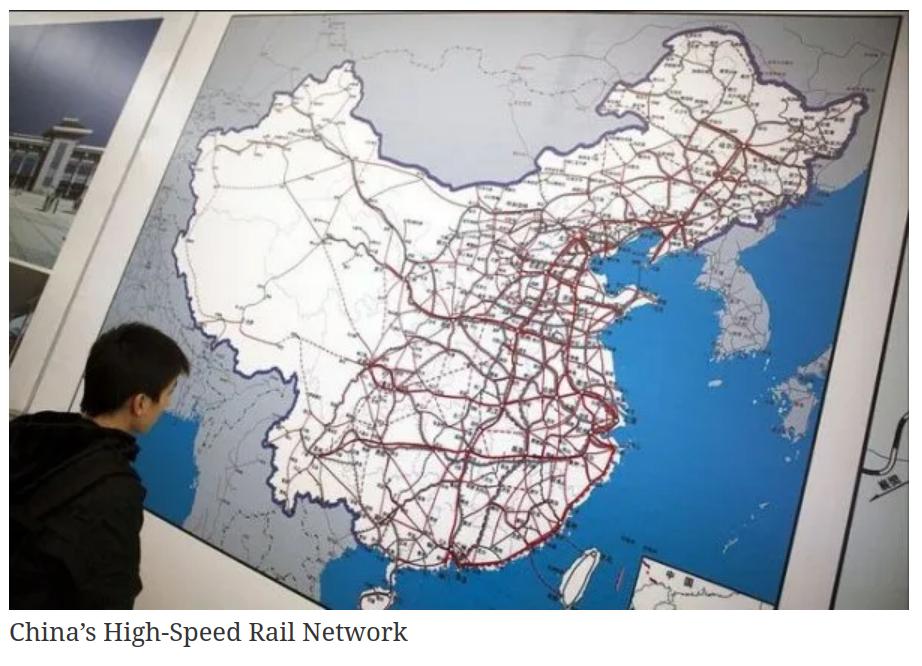
The Chinese government planned the HSR program in part to compress passenger travel on these dedicated tracks and free much of the slower existing rail system for freight, to remove trucks from the nation’s highways, thus lowering costs and in turn making highways safer for automobiles. The Shanghai-Nanjing route for example has 38 trains each way each day – carrying perhaps 150,000 passengers, which frees a huge amount of track time for freight. China’s high-speed trains have dramatically reduced the travel time between most major centers. Shanghai-Beijing is down from 12 hours to 4; Shanghai-Nanjing from 4 hours to 1; Wuhan to Guangzhou from 14 hours to only 3 hours.
There are always potential difficulties establishing routes due to the number of communities to serve and the consequent number of stops – which negate the advantage of high-speed trains. China seems to have arrived at an excellent solution. As an example, the 275 Km. route from Shanghai to Nanjing serves 6 communities between the two terminal stations, with some trains on this route travelling on an express basis and making no stops (1 hour), with others stopping at one or several cities on route, with different trains making different combinations of stops (1.5 hours). This has proven to be a convenient method to serve all cities on the route while still maintaining low average travel times.
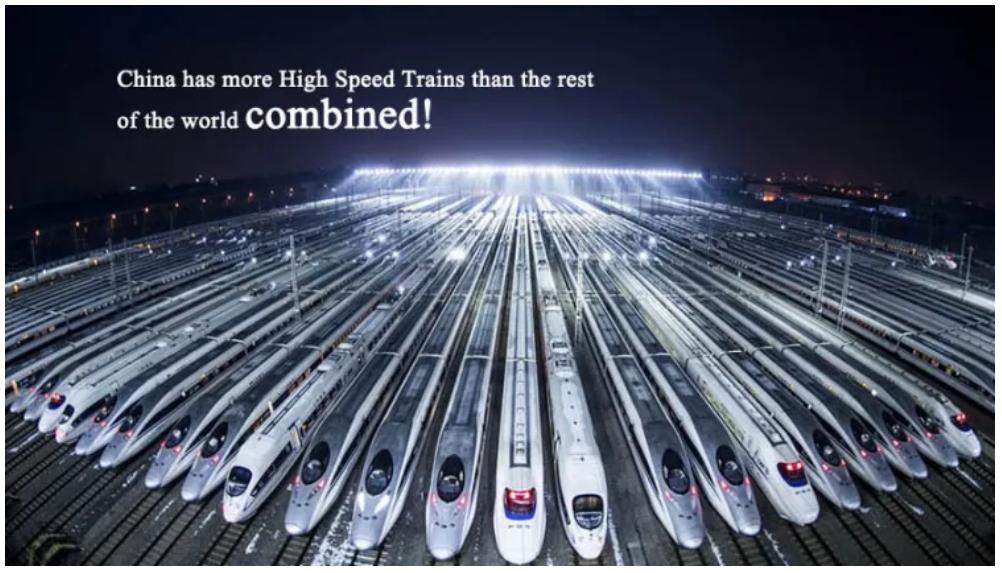
Many of the statistics and other information available online on China’s (and other) train travel are inaccurate at best, one website claiming China in 2019 had 1.4 trillion train passengers. Even Statista is quite inaccurate, confusing test runs of experimental trains with regular operating speeds of scheduled rail.[7]
France’s TGV is listed at its maximum one-time test speed of 575 Km/h, when it operates at only 300 Km/h. Statista has operating speeds wrong too, listing China’s Fuxing at 418 Km and Hexie at 486 Km/h, which normally operate at only 300 and 350 Km/h although they have proven capable of operating at these higher sustained speeds.
Train and Passenger Classes
China has three generations of high-speed trains in operation: G, D, and C. The G-trains are the fastest commercial-use high-speed trains in the world with speeds of 350 Km/h to 400 Km/h. The D-trains operate at 250 Km/h and the first-generation C at 200 Km/h. Below this, there are still the ‘normal’ trains with designations of Z, T, K, N and more. The Z, T and K trains run at 160 Km/h, 140 and 120. Slower trains are used for short rural trips where time is not so important.
These train alphabets are not nothing. I once took a G-train from Shanghai to Haining (the world-famous leather market), a trip of maybe 30 minutes if I recall correctly. I didn’t have a return ticket since I wasn’t certain of my return time, so I simply asked the wicket lady to put me on “the next train to Shanghai”. That was a big mistake. N-train. Ten kilometers per hour on the flat, much less uphill. That train stopped at every town, village, pig farm and strawberry patch on its way to Shanghai, and many times we had to pull off the track to permit a faster train to go by. Two and half hours to return home. I wondered why the ticket was so cheap. The kind of mistake you make only once.
I would note too that punctuality is a hallmark of Chinese transportation generally, this certainly applying to the HSR network. If the schedule states the departure time as 11:02, then at 11:02 the doors silently close and the train is moving. I’ve experienced a few departure delays, typically due to an arrival that is late, but usually by only 5 or 10 minutes. I don’t have available the percentage of on-time departures and arrivals but it must be in the high 90s.

.
These high-speed trains typically have cars that are First-Class, Second-Class and Business Class, and trains not dedicated to short runs have sleeper cars which are very clean and perfectly comfortable even in older trains, the later generations offering lovely duvets, a separate TV for each bunk, electrical outlets, lights, Wi-Fi. Regular sleepers have four bunks to a room while the highest grade has only two berths to a compartment, suitable for couples, and equipped with a sofa, a wardrobe, and private bathroom. Sleepers typically carry a 25% or 30% cost premium over regular seats.
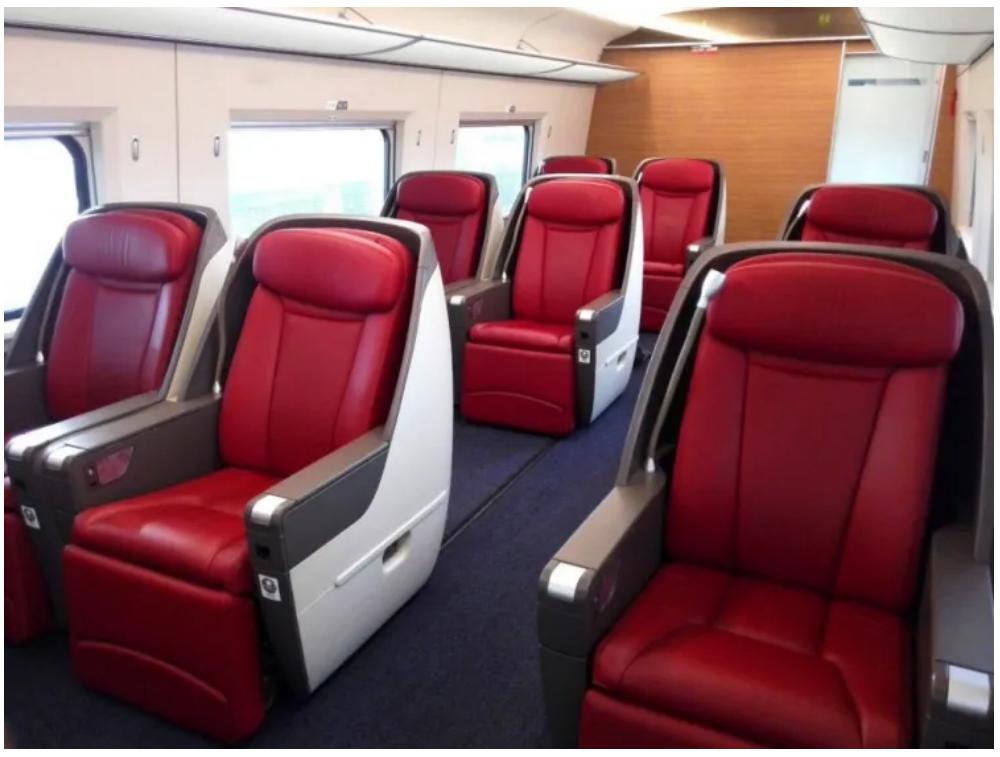
Business Class
These offer a pleasant alternative to air travel for the typically rushed and pressurised one-day business trips, for example from Shanghai to Guangzhou or Hong Kong. We board our train in the evening after dinner, do a bit of work or watch TV, and awake at 7:00 AM downtown at our destination, with enough time for breakfast before our first meeting. On the return trip, we have a leisurely dinner with friends, board the train across the street, and awake at 7:00 AM back in Shanghai. With two full nights’ sleep, there is no jet lag and no residual fatigue.
Here are some typical ticket prices:
G-train
- Beijing-Shanghai, 1,350 Kms; 350 Km/h (4 hours)
- 2nd Class, 550 RMB ($80)
- 1st Class, 900 RMB ($135)
- Business Class, 1,700 ($250)
D-Train
- Kunming-Lijiang, 500 Kms; 250 Km/h (2 hours)
- 2nd Class, 220 RMB ($30)
- 1st Class, 350 RMB ($50)
C-Train
- Beijing-Tianjin, 125 Kms; 200 Km/h (1 hour+)
- 2nd Class, 55 RMB ($8)
- 1st Class, 90 RMB ($13)
It’s almost impossible to compare train fares with the US because in China the fares vary only by distance and train type. Amtrak has a fare schedule that on first approach appears occult, apparently following the convoluted airline model of changing fares by time of departure and other secret paranormal factors, so a particular price could be almost anywhere. On some routes, twice the distance costs half the price. Still, they appear to be much higher than in China by a factor of perhaps 5 or more.
China’s Maglev Trains
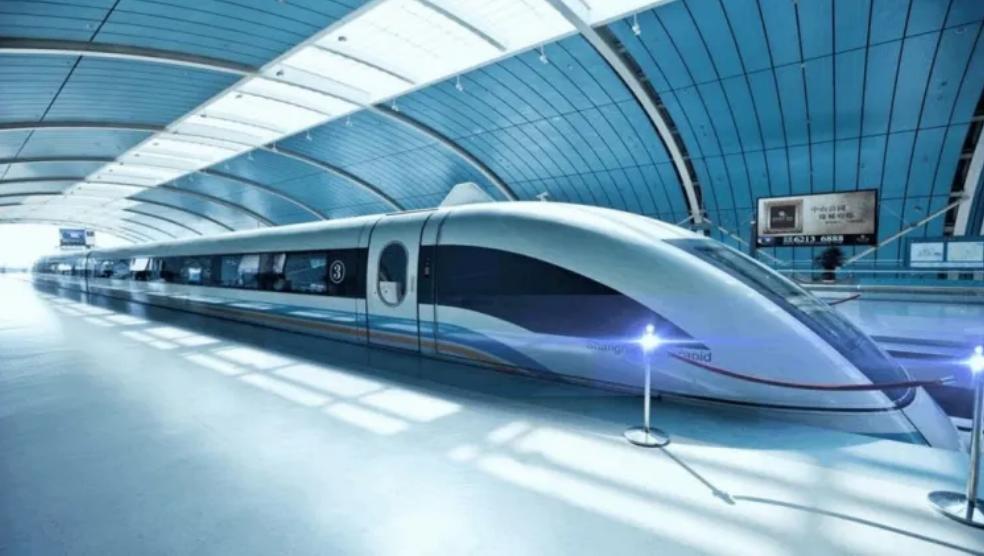
The first Maglev train in China was a Siemens design installed in Shanghai, with service beginning in 2004. It was until recently the world’s only regularly-scheduled operating Maglev (at 430 Km/h), but now they are becoming common in China. Maglev technology is simple in principle at low speeds, but smoothness and stability at high speed are exceptionally complicated. Maglevs have a higher level of safety in that they cannot be derailed since they ‘wrap around’ the track, and maintenance costs are low compared to rail trains because there is no wear on the track bed and few moving parts to degrade or require maintenance and replacement.
Chinese engineers initially produced quite successful low-speed Maglevs (200 Km/h) entirely on their own IP, for use throughout China as city trains, done to gain experience and develop their own proprietary designs and technology. These trains are now operating in Beijing, Changsha, and other cities, running on short local routes. There are few other Maglev trains in existence. Korea built a Maglev track to shuttle visitors at the Daejeon Expo, which still runs the few kilometers between the Expo Park and the National Science Museum, but it is very slow, and another in 2016 that runs only a few kilometers between the airport and a subway station, also very slow. Japan built its first “commercial maglev line” in 2005, with a route less than 10 kilometers and a maximum speed of only 100 Km/h – about the same as Shanghai’s new subway lines.
China’s 600 Km/h Maglev
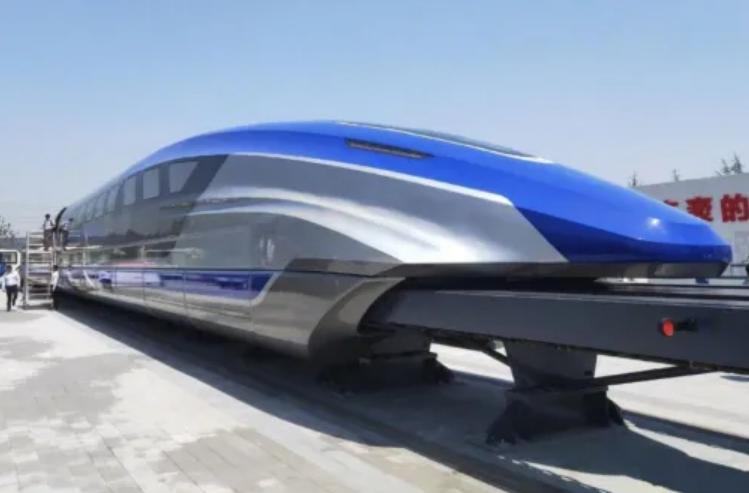
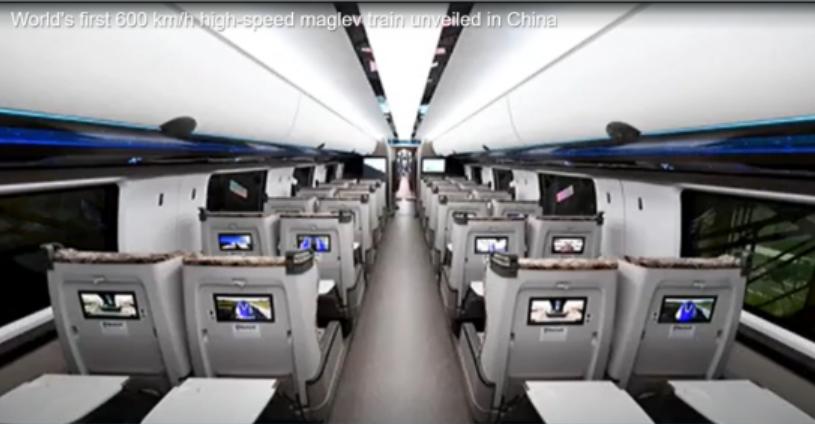
.
In addition to billions poured into R&D for regular HSR trains, Chinese engineers continued their Maglev research at a brisk pace, and have pushed Maglev technology to the point where China is now beginning commercial production of a fabulous 600 Km/h (nearly 400 Mph) Maglev which will replace traditional high-speed rail on many routes.[8]
Engineers spent much time on wind tunnel testing of the design of the locomotives and cars to reduce air resistance to a minimum, greatly assisting both high speed and stability. Chinese engineers have managed, again on their own IP, to bring down the cost for this very fast train to only two-thirds that of regular high-speed trains. This new Maglev will help to fill the gap between regular HSR and airplanes that fly at 900 Km/h or more, and it is likely that this gap will be closed further.
The Changes
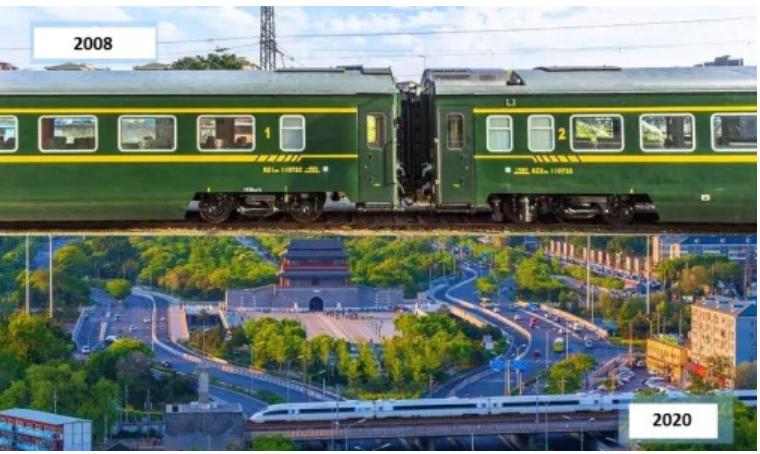
It is now legendary that when the Chinese government set its mind to an objective, it doesn’t waste time. Everything you have read above has happened in only the past 16 years. “At the beginning of the 21st century China had no high-speed railways. Slow and often uncomfortable trains plodded across this vast country, with low average speeds making journeys such as Shanghai-Beijing a test of travel endurance. Today, it’s a completely different picture. [China] has . . . the world’s largest network of high-speed railways, and all have been completed since 2008.”[10]
An aside: A Brief Note on Subways
Subways are not exactly high-speed rail, although China’s new trains are pushing the envelope in this area as well, at least up to 100 Km/h (almost as fast as American high-speed trains). However, another example of the Chinese not wasting time when they decide to do something. Shanghai and other major cities have set an objective that every place within the inner cities is within about 5 city blocks of a subway station. Here is a list of a few major cities with the current length of subway track and the time required to reach that level:[11]
- London 131 years, 400 Kms.
- Paris 122 years, 225 Kms.
- Berlin 119 years, 148 Kms.
- New York 113 years, 399 Kms.
- Shanghai 28 years, 900 Kms.
The Pleasures of Train Travel
One of the great advantages of HSR (High-Speed Rail) train travel compared to flying is the saving in wasted time. A flight in most any country normally involves a one-hour trip to the airport with a requirement to arrive at least 1.5 hours prior to departure which is frequently subject to delays. At the arrival end, there is always the seemingly long wait to deplane, the long walk to the baggage carousels and the exits, then the one hour or more trip downtown.
When we take into account the commute and the necessary pre-departure allowance for check-in and security clearance and the 2-Km walk to the departure gate, then the post-arrival delays and the commute downtown at our destination, trains are equal to flying in trips up to 1,500 Kms, and much faster than flying for shorter trips while also being less expensive. The frequency of departures, at least between major centers in China is astonishing, the Shanghai-Beijing route having some 75 or 80 HSR trains each way each day, often leaving less than 10 minutes apart with as many as 2,000 passengers (two trains linked into 16 cars). Many other routes are similar. The same is true with airlines in China, with flights seemingly departing from everywhere to everywhere every 30 minutes or so.
In China (and in most cities everywhere), the railway stations are downtown so the commute is minimal, one arriving at the station with luggage in hand only 20 or 30 minutes before departure. There is no ‘check-in’ process as with the airlines, only the usual security check and luggage scanners when entering the station where you can spend time in comfortable waiting rooms or simply find the correct platform and board your train. Even though many stations are huge, walking distances are normally much shorter than in most airports. At the destination, since that station is also downtown, taxis and subways are conveniently at hand. Also, in many cities airports and train stations are next door to each other, conveniently facilitating travel continuation.
Another advantage of train travel is the considerable convenience and comfort, trains being much superior in both categories with an absence of pressure and time apprehension. Trains eliminate most unpleasant elements of air travel, with the attraction of being able to see the countryside. On a plane, we are forced to adhere to a rigid schedule: the time for coffee or a meal, the time to close the window curtains and darken the cabin so the staff can rest. If the food cart is out, you cannot get up to walk around or go to the bathroom. Everything seems regulated and under pressure. Leaving your seat is often a major inconvenience. By contrast, on a train you are free to do as you please. Your luggage is accessible at any time, the food carts come by regularly, the dining car is always there, seats have twice the leg room, the aisles are wide enough to accommodate passengers; everything much more relaxed, pleasant, and enjoyable. And you have the advantage of constant Wi-Fi and GPS signals, with AC power and USB outlets usually available at your seat.
China’s high-speed trains are very quiet, without wind noise, and mercifully free of the incessant hum of aircraft engines and, with the flawlessly-welded rails, even the soft clacking of the rails is gone (I rather miss that). The seats are as wide or wider than airline business class, they recline partially (recline fully in business class) and, with the comfort and silence, it is very easy to sleep on a train. I would add that you are more alert (and healthier) on a train because aircraft are pressurised to 8,000 feet; you don’t normally go above 10,000 feet without supplementary oxygen.
They are also very steady. China has the highest standards for stabilising high-speed trains in their longitudinal, lateral and vertical dimensions, a rail expert stating “It is no exaggeration to say the Beijing-Shanghai rail lines were built with the highest standards in the modern world. China leads the world in rail stability.” Here is a Xinhua video of one of China’s high-speed trains where a coin rests on its edge on a windowsill for more than 8 minutes before it finally falls over – this at 350 Kms per hour. (12)
A Bit of Background
“High-speed rail” emerged first in Japan in the early 1960s with the construction of the Shinkansen ‘bullet train’ which wasn’t really all that fast at only 160 Km/h, but such speeds were unheard of in those days and the train was a world marvel. The European countries, led by Germany (Siemens) and France (Alstom), followed in the 1980s, with Canada’s Bombardier joining the group at about the same time. Nothing much was done outside of Europe, though the Europeans did embrace high-speed train travel and made good design progress.
It was widely assumed initially that there was no market for train travel, that the world would follow the North American model and rely primarily on the auto with the airlines as long-distance backup. But more than 40 years ago Chinese government officials saw the potential and disagreed, and began planning what would become the world’s largest HSR network, with enormous sums invested in the project. One expert wrote, “Chinese engineers have exhibited enormous ingenuity and creativity and are still aggressively pushing the rail technology envelope.” It is generally agreed that China’s success in high-speed rail development and its cost reduction, has resulted in “validating the feasibility of widespread adoption and greater affordability. Developing countries are particularly grateful that China has brought the cost of HSR to affordable levels.” One expert wrote, “It appears now that China will dominate the HSR market for the foreseeable future.”
And indeed, developing countries are increasingly attracted to the prospect of China’s affordable HSR trains as an impetus for their own economic development. At the time of writing, Chinese railway firms were building a high-speed line in Turkey linking Ankara and Istanbul, another project in Venezuela, and expecting contracts in Brazil, Russia, Saudi Arabia and Poland. Railway routes in China are expanding to mesh with new routes in Vietnam and Thailand, and there are plans to extend a route all the way to Singapore. Chinese rail officials are in the planning stages of a high-speed rail route passing through Xinjiang Province in Western China, through Kyrgyzstan and other ‘Stans’, connecting with lines in Turkey and proceeding Westward into Europe. It may soon be possible to travel by HSR all the way from Shanghai to London – at a fraction of the cost of flying, and with far more comfort and the ability to see maybe 15 countries on route.
Chinese engineers have said it is well within the limits of today’s technology to build a high-speed rail line between China and North America, the line passing through Siberia, with a tunnel under the 55-mile Bering strait separating Russia from Alaska, then down the West Coast of Canada and the US. It would then be possible to take a fast train from San Diego to Paris and London. However, politics will make such a development impossible.
Technology Transfer is not Free
Whenever the subject of technology transfer arises, there seems to always surface a flurry of accusations about copying or stealing. Readers should carefully note that China did not “steal” anyone’s rail technology; instead, it was all purchased. China paid billions of dollars for that transfer of technology. It is the same in all important industries today. China has the money, and is willing to pay handsomely for technology it needs to further its development.
To compensate for a late start, the Chinese government began (in only 2004) by purchasing rail technology abroad, signing agreements with Alstom and Kawasaki to build HSR train sets for China in cooperation with local firms. Kawasaki, who designed the original Hayate bullet train, signed a deal with the Chinese ministry of Railways for the transfer of a full spectrum of HSR technology. They began with Kawasaki manufacturing 50 HSR train sets in Japan and exporting these to China fully-assembled, then progressed to establishing factories in China where Kawasaki helped the Chinese manufacturers to produce another 50 train sets locally. China also paid Kawasaki for the training of manufacturing staff first in Japan and then at the factories in China. This process carried a heavy price; the arrangement with Kawasaki cost China around $800 million, plus countless millions for training and many technology updates. The contract with Kawasaki included “the transfer of the whole spectrum of technology and know-how for the bullet train”, so that these trains became in fact Chinese-owned IP.
With this experience under its belt, China then duplicated the process with Siemens, Alstom and Bombardier, in similar deals for a full transfer of technology and IP rights so that China could freely manufacture these train sets domestically and sell them internationally. Similar to the procedure with Kawasaki, Chinese engineers were sent to Europe for extended periods of study and also had these firms assist China in establishing domestic manufacturing facilities. All the firms trained Chinese engineers while helping the country develop its own supply chain for train components, and all of this involved several billions of dollars in fees.
But it wasn’t all gravy because the Chinese rail companies paid billions of dollars for was in fact old technology from those four companies. Knowing the Chinese wanted to produce trains based entirely on their own IP and technology, Kawasaki and Siemens in particular refused to sell their more advanced products and would sell China only rail technology that was already two or even three generations old. These foreign companies were actually planning to take full control of China’s vast market for HSR transportation, expecting to fully supply the “the most ambitious rapid rail system in history”, with rewards in the billions.
That did not deter the Chinese. As a first step they disassembled, evaluated, and combined all those technologies into one train, combining the best features of each. Then, they applied their formidable R&D abilities to improve and enhance those features and create entirely new trains built exclusively on Chinese-owned IP. The result was trains that were faster, smoother, quieter, and less expensive than the newest generation of their former suppliers. To say that the foreign firms underestimated the power of Chinese innovation and the speed and quality of R&D in China, is an understatement of some magnitude, with both Kawasaki and Siemens finding themselves left at the starting gate only a few years later.
“The Western firms confused their head start with their R&D capacity, attributing both to natural superiority, confidently assuming they were more innovative rather than simply having begun earlier. The assumption was that Japanese and German R&D capability coupled with their huge lead would maintain an impassable gap and permit them to capture the entire Chinese market.” Their willingness to sell their technology was from an expectation that the Chinese would need at least 30 years to absorb and implement it before being ready to proceed on their own. The reality was somewhat different: they found themselves having to compete with Chinese firms who adapted and improved their technology and produced superior products only three years later.
And Some Sellers Remorse
When China proved its ability to combine technologies from all firms and create a new, superior product, the Japanese appeared quite bitter, Kawasaki going so far as to claim that China’s trains were just ‘tweaked versions’ of its original bullet train with minor variations to the exterior paint scheme and interior trim. Even nastier, Japan’s Ministry of Transportation was quoted as saying that Japanese trains could be just as fast, but China’s trains were faster only because the Chinese ignored safety and didn’t care how many people died.
Of course, the real problem was that it was impossible for Japan to compete with China on international markets since they hoarded their technology for too long and, by the time they changed their attitude, the world had passed them by and their technology was old, with Chinese trains much nicer, 100 Km/h faster, and considerably less expensive. As someone wrote, “Marketing is difficult when your only selling point is that the other guy’s fast and affordable trains are copies of your slow and expensive ones”. Something similar occurred with Shanghai’s Maglev train. Due to pride of authorship as with the Japanese, Siemens also refused to consider a sale of technology, preferring to hold out for astonishingly high prices of the finished product. The result was that Chinese engineers turned their full R&D attention to Maglevs and Siemens now finds itself permanently sidelined in the market.
World Leader in Construction Quality
China’s HSR system is built to an intense high quality. Chinese high-speed trains run on special dedicated, often elevated tracks laid on deep and heavily-reinforced beds of high-density concrete with vertical and horizontal deviations measured in millimeters, these tracks supported by massive columns of high-strength concrete spaced very closely. With high-speed trains there is no chugging uphill and racing downhill; HSR tracks are, insofar as is humanly and technologically possible, a straight and level line. Typically, a horizontal elevation is selected for a particular route, with the rail bed maintaining this throughout the route. Depressions and valleys are filled in with bridges, and mountains and hills are met with tunnels.
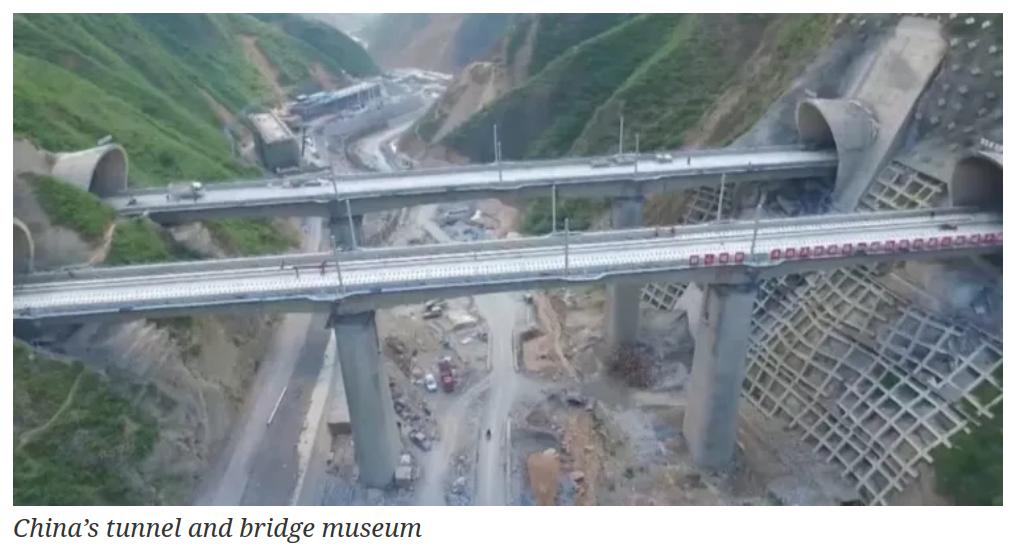
This can be more difficult than appears at first glance. China has some astonishingly-beautiful landscapes that are perfect for tourist admiration but not so attractive to railway engineers. One such route is a line running through beautiful but challenging mountainous terrain from Wuhan and Yichang (the site of the Three Gorges Dam), to Wanzhou City, just East of Chongqing. This was China’s most difficult railway to build and is the world’s most expensive railway, costing 60 million RMB (roughly US$10 million) for each kilometer. It took a staggering seven years and 50,000 workers to complete. Of the route’s total length of 380 Kms, 75% percent or 280 Kms, consists of 253 bridges and 159 tunnels. Each and every kilometer of the railway contains at least one bridge or one tunnel, most often one of each, leading the locals to refer to the railway as the “tunnel and bridge museum”. It is ironic that this railway was meant to operate at the highest speeds of the day, but the terrain proved so difficult and consumed so much construction time that when completed the system was two generations old. And, given the immense difficulties, there is nobody interested in starting again to update the track and systems. But still, this railway reduced the Yichang-Wanzhou travel time from 22 hours to just five hours, bringing new opportunities for residents who live in the steep and remote Wuling mountains. One local resident said, “We used to pay 100 Yuan (US$15) for a one-day bus trip to Yichang before. Now, 30 Yuan can get us there in two hours.” I covered this in a brief article which you may enjoy reading.[13]
A Note on Train Safety
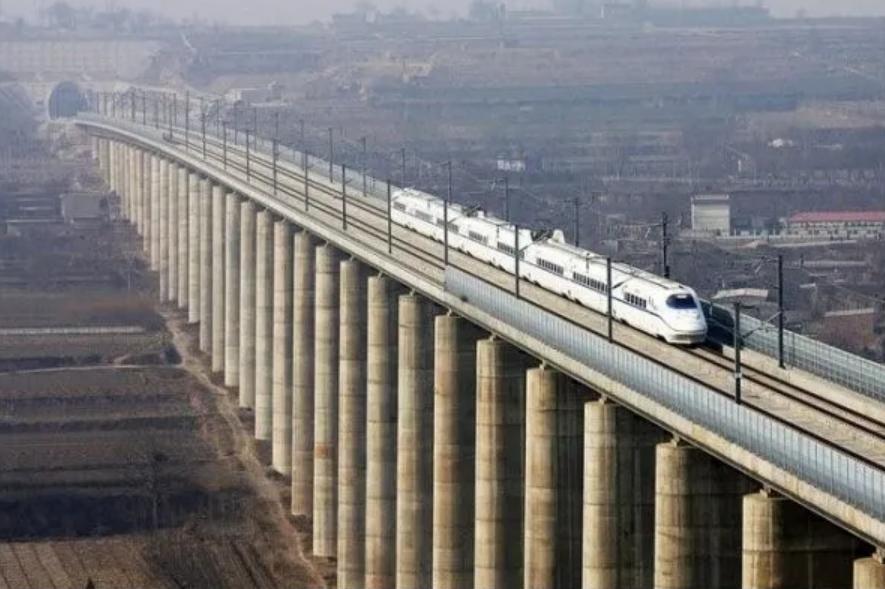
Chinese high-speed trains are often completely separated from the landscape, running on dedicated tracks elevated well above roadways, with no level crossings or cross-traffic, and thus no possibility of the common variety of vehicle accidents. These high-speed trains descend from their elevated perch only when approaching a station, utilising regular trackage for this purpose but only at very low speeds, thus permitting transportation literally from city center to city center. You can see the elevation and extreme support in the photo. There are of course sections of trackage at grade level in areas where safety is assured, but extreme precautions have been taken to avoid roadway crossings which are usually handled by either elevations or tunnels.
As with every country, China does of course have its share of train accidents, with older trains derailing from landslides or other causes but, given the country’s massive rail network, the number of trains operating and the sheer number of trips taken, the country’s accident record is actually remarkably low, as are the fatalities.
China’s railway system has dozens of installations across the country where every high-speed train is constantly monitored for many metrics like speed, axle temperatures, weather conditions, and obviously also for precise location and track position of every train. Their focus on safety is extreme. The country’s high-speed system has had only one accident since inception (at Wenzhou in 2011), one that was eerily reminiscent of Boeing’s 737 Max, where a major programming change was not covered in the operating manuals for the Japanese signaling systems. The Japanese, apparently feeling a concern that the Chinese could reverse-engineer the systems code, deliberately omitted some of the operating functions from the manuals, and so provided faulty documentation that left the Chinese operators with an imperfect and incomplete understanding of the signals systems.
In this case, a train was hit by lightning and was stalled on the track. When this occurred, Chinese engineers immediately knew something was wrong and followed the operating manual, but they had no way of knowing the system was telling them that a train was stalled on the same track, because the manual was incomplete. This was the actual cause of the crash. It was true that local officials in Wenzhou panicked and stupidly tried to cover up the fact of the crash, but that doesn’t change the cause. I would note further that this was by no means the first time Chinese engineers had been deliberately misled on either the function or operation of IP they had bought and paid for. There are many tales of foreign engineers telling outright lies about the purpose or function of various components, leaving the Chinese to either figure it out for themselves or discover through adverse events the actual purpose.
This accident was widely-reported in the Western media, but only to gloat at China’s misfortune. Forbes and the WSJ (and of course the NYT) ran articles that were particularly nasty, with the Carnegie Endowment publishing what seemed a very stupid political article claiming the train accident “Shows the Dangers of China’s Nuclear Power Ambitions”.[14]
The point appeared to be that, since China had one rail accident, they could not be trusted to ever build anything. The child-writers at the Economist gleefully ran an article with the cute title of “Whoops!” and, in another context, the Economist wrote, “To err is human. To gloat, divinely satisfying.” Exactly.
I would also add that on the event of that accident, the US media were so delirious with schadenfreude that few bothered to report the actual cause. It happens that most every opportunity to criticise China will be transformed into a proven failure of China’s one-party government. In reporting on this train accident, the entire Western media eagerly pinned the blame not on a Japanese signals failure but on China’s one-party system. But Wikipedia lists 70 pages of rail accidents for the US alone, having several major and a bunch of minor ones every year. Since theology must be universal to be credible, it seems clear where the fault lies for all these terrible disasters: democracy causes train crashes.
The topic of rail safely seems heavily politicised. For some unknown reason, the Western news media persist in promulgating a fiction that Japan (unlike China) has a perfect train safety record, but the truth is that Japan’s bullet trains derail and crash with some regularity. Wikipedia obligingly provides a full listing of train accidents in China all on one page, but one must work very hard to find a similar convenient listing for Japan.
Kawasaki Meets Godzilla
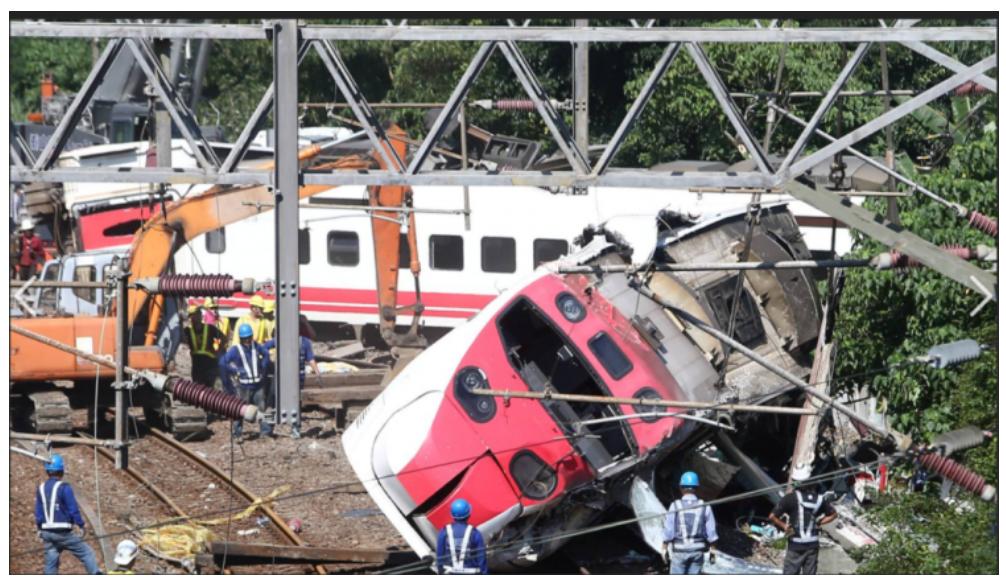
Rail Infrastructure is a Public Good, not a Private Benefit
Due to its unique government structure, China is able to plan and amend its entire travel infrastructure as a whole, considering air, rail and road, taking into account only the benefits to the entire country rather than having to appease a multitude of private interests. HSR trains have cut travel time so dramatically that airline services on many routes have been suspended in whole or in part. The airlines may not always be pleased, but China’s transportation system is designed for the maximum overall benefit to the nation, not to serve specific private interests or friends of the Administration.
China has not succumbed to the sometimes-intense privatisation pressure from Western bankers and has retained control of its infrastructure, an enormous blessing for rapid and efficient development. Chinese leaders recognised from the beginning that economic development follows transportation, and thus maintaining control of the transportation infrastructure derives from a determination to distribute the benefits of development to the entire nation. The reality is that not all infrastructure is destined to be financially profitable – profitability being the only measure by Western standards. A privately-developed railway system would be built only on the most profitable routes, those likely to amass billions for their owners but that would leave perhaps half the nation destitute for transportation and sentenced to perpetual poverty. Thus, railway privatisation would saddle China’s central government with the costs of building and supporting all the unprofitable routes without benefitting from the profitable segments. This is one of Western capitalism’s main mantras: privatise the profits and socialise the losses. If you’re interested in this topic, here is an essay you might enjoy reading: Private Enterprise and the National Good.[15]
In the absence of competing interests, a nationwide plan can be conceived, examined, discussed and approved in a much shorter time than in countries with a different system, and implementation times much reduced as well. China’s new HSR line from Shanghai to Beijing, a distance of about 1,300 Kms was a masterpiece of unobstructed planning and execution. For construction, the government hired almost 140,000 workers to build multiple sections simultaneously, the entire project completed in two years at a cost of less than $20 billion. By contrast, in the US, the cost of an HSR line along the Eastern seaboard, a distance only half as long, has been estimated at $120 billion and might require 20 years to complete. The province of Alberta in Canada is considering an HSR line of only 300 Kms connecting the two major cities, yet the planning stage is expected to take 5 years and cost $50 million; if approved, the subsequent construction process is projected to require another 5 years at least. The interim negotiations for right of way, the bidding processes, the dealing with all the various private interests as well as the cities involved, are expected to add 5 years to the process.
It is critical to note that economic development follows transportation. Countries like Canada and the US would never have developed without the cross-country transportation systems being in place. But it is almost certainly too late for both Canada and the US with high-speed rail, too many decades of auto-dependent development condemning both countries to irreversible transport deficiencies. In the US, General Motors (aided by a few others) managed to convince the individual states to abandon all investment (and maintenance!) in railways and other public transport, and instead make huge public expenditures on highways that were useful only to those who owned private automobiles, effectively stranding all other citizens at home with no way to go anywhere and virtually forcing everyone to buy a car. This is not trivial, but instead a critical historical narrative. One observer wrote that “A theme likely to be emphasised in history will be the enormous strategic error made by both the US and Canada in enslaving themselves to individual motorized transportation.” Here is an article I strongly urge you to read:[16]
As with most other subjects, the Internet is not lacking uninformed nonsense on HSR trains. One US source tells us, “The United States has no HSR corridors because high‐speed rail is an obsolete technology that requires expensive and dedicated infrastructure that will serve no purpose other than moving passengers who could more economically travel by highway or air.” The preceding comment is incorrect in too many ways to count, ignoring the political factors that are actually responsible for the absence of HSR in the US. Rail is inevitably the least expensive form of land travel (except for bicycles), is provably less expensive than driving (sometimes much less), and generally less expensive than air travel.
The American Experience
In 2012 and 2013 the US wallowed in an anguish created by envy of China’s high-speed rail network, America’s rickety and accident-prone rail system suffering badly in comparison. When it became apparent that the Americans could never duplicate China’s success and, confronted with the imminent failure of their ambition to join the world of high-speed rail, the Americans revised the definition of high-speed trains from 400 Km/h to 250 and then 150, before abandoning their quest altogether. Then, rationalisation through the uniquely American moral lens of politics and religion: “Our slow rail network is the price we pay for the great things about America like our democratic political system and our freedom of religion.”
An internet reader commented:
“The American failure to realise an HSR system is not because China has better leadership, vision, planning and execution, and the wisdom to sacrifice short-term benefits and minority interests for the long-term gain and the greater good; it’s because Americans have democracy and love freedom. The bickering and indecision, the squabbling, the vacillation and eventual paralysis of all levels of US government on this issue, an impossibility in any sane country, are actually a badge of merit in America, evidence of their virtuous freedom. So, let China build its high-speed trains. The more trains they have, the less free they become. Americans would never be so foolish as to sacrifice freedom for good transportation or democracy for roads and bridges.”
I don’t know the author of this brief passage below, but I want to share the quote with you because he captured perfectly the American situation:
“At the end of 2013, California was still hoping to build the nation’s first high-speed rail line, an 830 Kms track from Los Angeles to San Francisco, that would be scheduled for completion in 2029 (more than 16 years) and would cost about $70 billion not including the inevitable cost over-runs. By contrast, China built its 1,320 Kms Shanghai-Beijing HSR line in only three years at a cost of 200 billion Yuan – about $32 billion. So, the US high-speed train – if it’s ever actually built – will be 60% slower than China’s, will take five times as long to build and cost almost five times as much for an equivalent distance. Of course, the Americans could just ask China to build their HSR in only 18 months at a cost of only $20 billion, but that would mean admitting Chinese superiority, and that means the US will never have high-speed rail.”
Amtrak is the only intercity passenger rail in the US that operates at speeds higher than freight trains, but hasn’t been very popular, with its highest passenger numbers at around 30 million in a year compared to China’s nearly 4 billion. And Amtrak has never made a profit, requiring government subsidisation of about $1 billion per year. I have no explanation for the lack of popularity of train travel in the US. It isn’t primarily a love affair with the auto, since Europeans also love to drive but also love train travel. At least some US rail facilities are acceptable, so it would seem the problem is due to a sum of other factors.
Amtrak
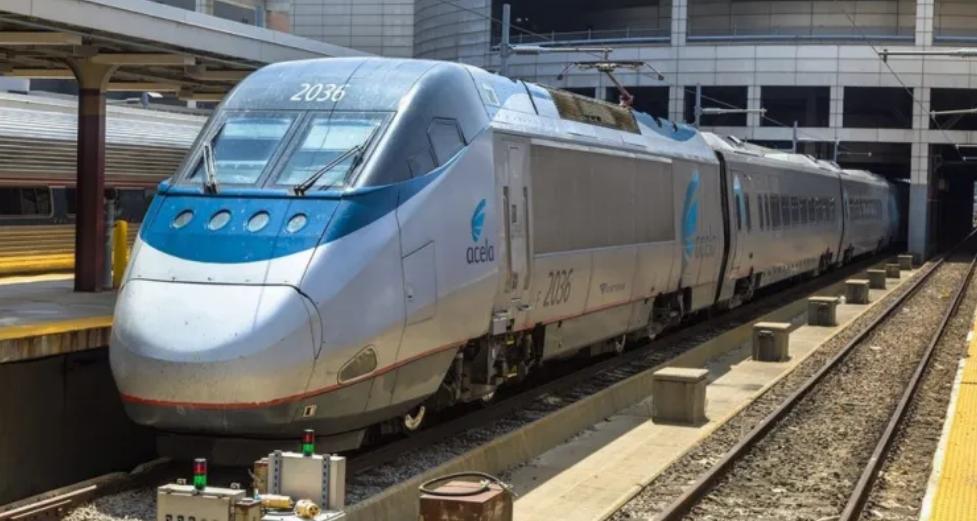
Amtrak is a very strange duck, a high-speed wannabe that seems determined to get most of the important things wrong and, if I can use an analogy, is too busy reading to take the time to learn to speed-read. It is difficult to make positive statements about the company because the underlying negatives make positive statements seem almost surreal.
Recent media reports that the introduction of Amtrak’s new Avelia Liberty trains (If it’s America, it’s always ‘liberty’ or ‘freedom’) manufactured by France’s Alstom are facing yet another delay of 18 months, pushing the total delay to more than three years. The cause? Surprising, to say the least. To begin, under new instructions to ban everything Chinese, the company had to turn to France to purchase their rolling stock, but what Amtrak has purchased is 3 generations old in China, at the very bottom of anything that today would be termed “high-speed rail”, and is old in France as well. Reading between the lines, it seems Alstom agreed to reproduce some older-technology equipment to match America’s abilities, but things haven’t gone so well.
According to Amtrak executives, the need for more testing is the cause of things being behind schedule, with Amtrak citing “rigorous” testing “required by federal regulations”, somehow implying American safety standards of exceptional rigor, but the details seem to tell a different story. In fact, a review of the details reveals that the real cause was “the discovery of compatibility problems with the Northeast Corridor tracks that prompted modifications to the train design”, as well as “an incompatibility with . . . its catenary system” – which is the overhead electrical source that provides power to the trains.[17]
If this isn’t clear, Amtrak executives discovered, no doubt to their complete amazement, that the trains they purchased didn’t fit the tracks on which those trains would run, nor could they connect with the available overhead power sources. The spin placed on this by Amtrak executives was that “The train had to be modified to work harmoniously with the infrastructure.” However, it wasn’t an issue of ‘working harmoniously’, but of working at all. Amtrak provided to Alstom the design necessities for 30 new train sets, which were manufactured to those specifications but, when delivered, the company discovered their design was so badly flawed that the new trains didn’t match the trackage or the power supply, and had to be modified. This sounds like a Three Stooges episode or a Jackie Gleason comedy. How is it possible for thinking persons to design and manufacture trains that can’t fit their own tracks?
According to media reports these new Avelia trains are built under an FRA rule that establishes “new safety standards for high-speed trains, . . . to allow for operation at the highest speeds on shared tracks”. The intended insinuation is that these new so-called safety standards are more rigid, but it seems they are actually more relaxed, to accommodate Amtrak’s inability (or unwillingness) to comply. Part of the problem is that Amtrak runs almost exclusively on what they euphemistically call “shared tracks”, which means running on 60 year-old rail beds that are used primarily by slow freight trains, and that Amtrak wants to run its trains at speeds much higher than are safe. Hence the “new safety standards” created by the FRA “to allow for operation at the highest speeds”.
Amtrak Also Meets Godzilla
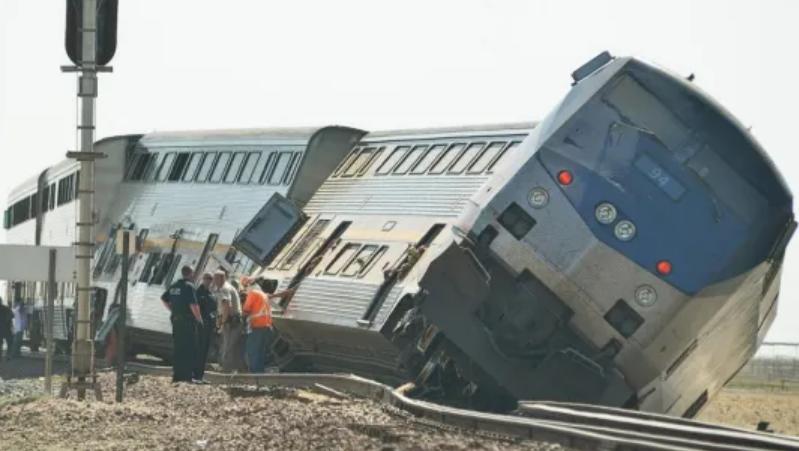
“Most American (rail) infrastructure was built in the early to mid-20th century (1920-1950), the continent having been simultaneously wired for electricity and phone service while constructing the interstate highway system along with thousands of bridges, tunnels and more. But the US has spent almost no money on maintenance and repairs on any of this infrastructure for almost 60 years now. The situation today is dire and, in many instances, critical, but money is no longer available (except for Israel and Ukraine). Derailments and other accidents occur almost daily on America’s dilapidated and unsafe rail network which, like the highways, has received only urgent patching rather than proper maintenance and repair.”[18] [19] [20]
“In June of 2013 an Interstate bridge on a main commercial corridor between Seattle, Washington and Vancouver, Canada, collapsed and fell into the river below after being hit by a truck. This was not a high-speed collision; the truck simply bumped one of the main support pillars at low speed, but the weakened and dilapidated pillar broke from the strain and, without that extra bit of support, the entire bridge immediately collapsed. In prior examinations, the heavily-travelled bridge had not only been rated as functionally obsolete but structurally deficient and requiring replacement. This is only one of thousands; the great majority of the physical infrastructure of the US is in a similar condition, involving railroads, highways, dams, bridges and more. More than 160,000 bridges in the US are officially categorized as dangerous, at risk of collapse, with such collapses now regularly occurring.[21][22][23]
The same is true for subways and elevated inner-city rail systems like that in New York City; rickety, dirty, dangerous, and looking for a reason to collapse.”[24]
Welcome to New York
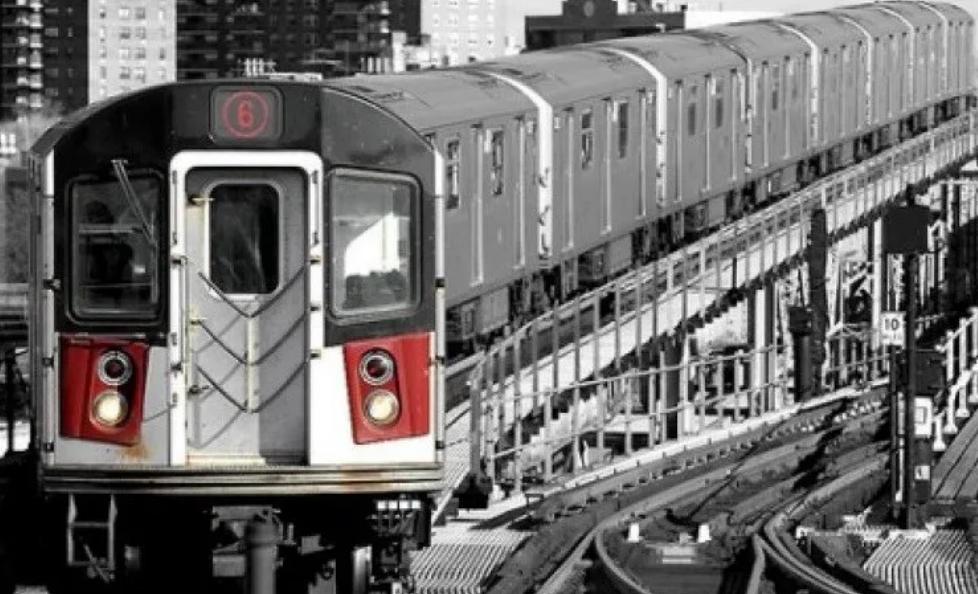
Back to Amtrak, the delivery delay “hiccups” will force the company to keep its “legacy fleet” in service, with this in turn causing severe revenue losses from the oddly-unexpected need for extra “mechanical investments” to “reduce train malfunctioning”. In non-propaganda English, this means that Amtrak’s old, one-foot-in-the-grave, trains needing badly to be scrapped before an imminent fatal collapse, will now require substantial maintenance and repair to hold out until executives can accurately measure the width of their tracks and modify the new trains they’ve purchased.
This is not nothing. Amtrak experiences operating difficulties we don’t even read about in comic books. One Amtrak passenger train in Maryland recently broke apart while traveling, with some of the passenger cars separating from the rest of the train at 125 mph and going on their own merry way.[25]
Until this, I thought I’d heard everything. Amtrak executives said, “We are currently investigating the cause of the car separation.” I guess I would be doing that, too.
Would you like to travel at 250 Km/h on this track? Amtrak wants to.
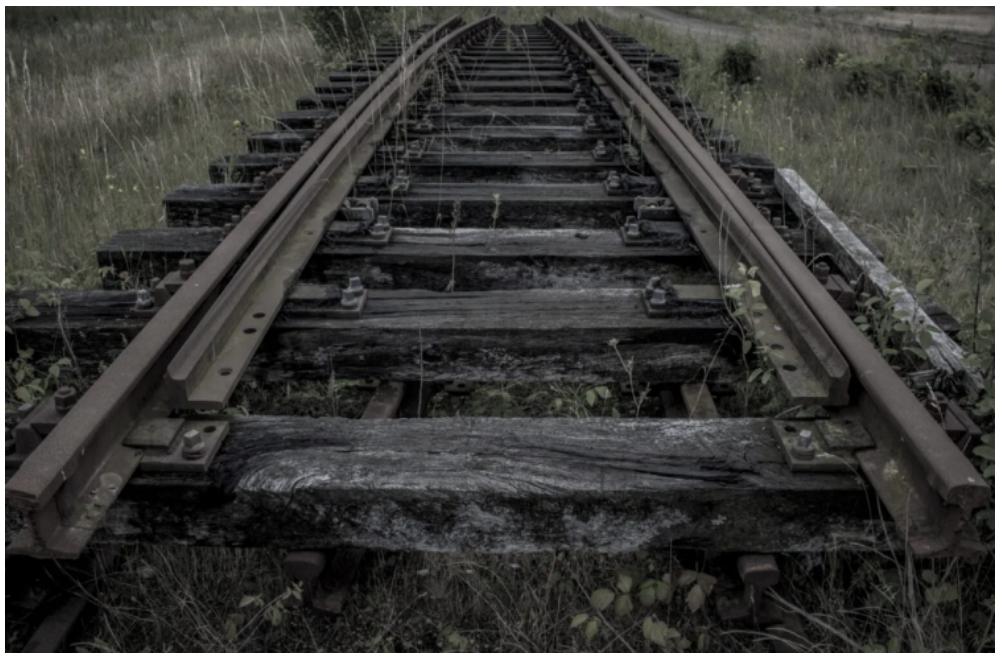
But the most important issue is that no one in the US, neither the government nor the railways, seems prepared to maintain and repair rail tracks and beds to an acceptable standard, much less having the foresight to build dedicated trackage meant for high-speed trains. Attempting to run trains at speeds of 200 mph on 60 year-old un-maintained tracks that were built for freight trains at a maximum of 50 mph, is not only reckless but downright stupid. Yet, this is where we are. And Amtrak’s legacy of accidents and crashes is all the evidence necessary.
Train speeds are constantly an issue with Amtrak. We can read much hype about Amtrak trains traveling at 200 or even 250 Km/h (150 mph), but in real life they barely average 75 or 80 mph, and this is the fastest train in America. This is partly the fault of the tracks, since Amtrak operates almost exclusively on freight train tracks and ‘shares’ the tracks with these freight trains, and is often held up by them. I’m told it is quite common for an Amtrak train to get stuck behind a slow freight train.[26]
But even with all of this, very few of Amtrak’s locomotives have the ability to exceed 110 mph or 175 Km/h, which is well below anything considered as high-speed rail today.
DC to Boston is roughly 700 Kms or 435 miles. Amtrak’s Acela Express Train 2150 takes nearly 7 hours, for an average speed of only 100 Km/h, or 60 miles per hour, not exactly high-speed. That’s not entirely the fault of the train, since it makes ten stops on the route, a case of bad planning if I ever saw one. As mentioned above, China’s solution to this is to have some trains run on an express basis with no stops between the two terminals while others make several different stops each, thus still serving all the communities but with a much higher average travel time.
Similarly, Amtrak’s record of on-time arrivals is abysmal. According to Amtrak’s 2020 Annual Report, little more than 55% of trains arrived on time, and this can be blamed almost entirely on poor management. If China and many European countries can have on-time rates of up to 98%, so can anyone who knows how to plan.
Richard Branson’s Brightline
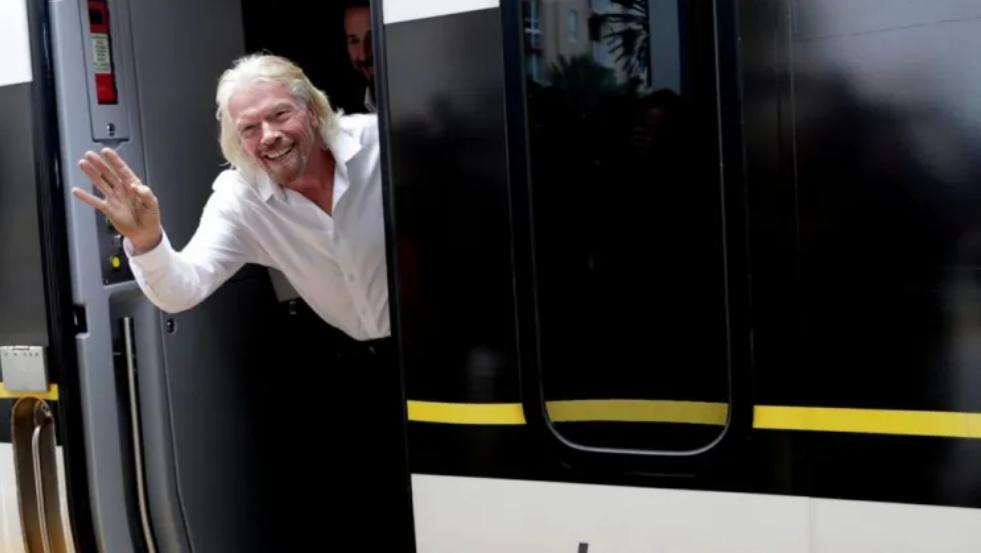
However, unknown to the world at large, America does indeed have a “high-speed train”, Richard Branson’s new ‘Brightline’, that runs 100 Kms from Miami to West Palm Beach in Florida. According to the promotions, these are “sleek, neon-yellow trains, which travel at speeds of up to 127 Kms/hr (!!!)”.
To be fair to the Americans, they initially promoted this as a “higher-speed train”, a small but worthy concession to reality that quickly disappeared. To be fair to the sleek, neon-yellow train, it is quite unable to reach its advertised top speed and in fact seldom reaches even 100 Km/h, faster than a freight train, but not by very much.
Also unknown to the world, this American version of HSR has, in its first few years since inauguration, had numerous derailments, scores of accidents, and caused well over 100 deaths. In what should have been a surprising development, several of the accidents and deaths occurred during the train’s initial test run, after which it was inexplicably cleared for service. But perhaps no matter because Brightline assured us that “safety remains the company’s top priority”. Interestingly, the US Federal Railroad Administration (FRA) data show 60% fewer deaths than the media reports of actual fatalities because (if you can believe this) they inexplicably (and almost certainly unjustifiably) classify most of the deaths as “possible suicides”, and then sanctimoniously impose “reporting restrictions intended to safeguard privacy”.[27]
If this isn’t clear, the FRA is claiming that 60% of Brightline train accident deaths were from motorists deliberately stopping on the tracks in order to kill themselves. Given all the options for committing suicide, this would not be my first choice. How can American authorities fabricate such preposterous lies and why would the media support them?
Another Brightline “Assisted Suicide”
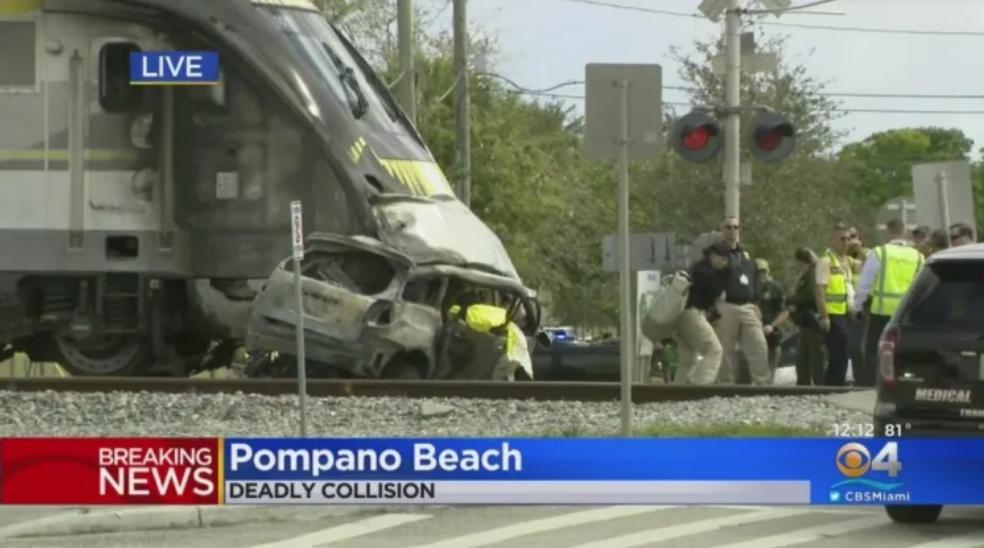
Also, according to the FRA, “a Brightline locomotive derailed … at four miles per hour …”. The report continued that this was the second derailment within two months, the main cause being that this US “high-speed train” is using tracks and rail beds built more than 60 years ago, intended only for slow-moving freight trains, and have not been maintained. In an astonishing display of arrogance and defiance, Brightline refused to confirm the accident for nearly six months, even during sworn testimony to a Senate Committee, then called the derailment “minor”, and dismissed the critics’ concern as a “baseless fear tactic”.[28]
These issues are noteworthy in several ways: Running “higher-speed” trains through level crossings (at ground level), is reckless in the extreme and begging for fatalities. Even more, running passenger trains on dilapidated trackage and freight-rail beds that haven’t been maintained for 60 years, is worse.
A second item is so illustrative of a pathological quirk that appears to exist only in the US. From Brightline’s home webpage:
“Hand-stitched leather seats. Sit 2 or 4 together at a table. Relax pre-departure in our first-class SELECT lounge with an ever-changing lineup of enticing bites and beverages. Lounge business services including iPads, a scanner & printer. Access to conference rooms in our stations (a $50/hr value). Complimentary onboard Wi-Fi.”[29]
Hand-stitched leather seats and an ever-changing lineup of enticing bites on a train that derails at 4 miles per hour and has already killed more than 100 people. This is the way Americans design their cars. Appearance is everything and substance is nothing.
American auto designers hold frequent market tests where they introduce citizens to new automobiles, the purpose being to see if the new degradations in quality and safety can pass these public tests undetected. A so-called high-speed train running on rickety tracks and derailing at 4 mph is glossed over for leather seats and Wi-Fi. Only in America. One internet commenter wrote, “This proves that Americans are too stupid for high-speed rail.”
“How many more deaths do we need to read about before something is done.”
Another news report stated that – according to the same FRA – this train has had “the most fatalities along the corridor in that time period”.[30][31] The situation is so bad that there are at least two Florida law firms now specialising in Brightline accident victim litigation.[32]
A recent article in the Orlando Weekly called “almost-high-speed Brightline the deadliest train line mile-for-mile in the U.S.”,[33]
because it apparently has the worst death rate of all 821 train lines in the US. Yet Branson plans to extend the line to Disneyworld and has obtained billions in tax-free bonds for the expansion, but there are current lawsuits to prevent this, determined “to ensure it never reaches Orlando”.[34] Nevertheless, and again, “the service intends to use existing freight lines that have not handled regular passenger service in nearly a half-century” and which haven’t been maintained for 60 years.[35]
Only in America.
Does This Look Like a High-Speed Train to You?
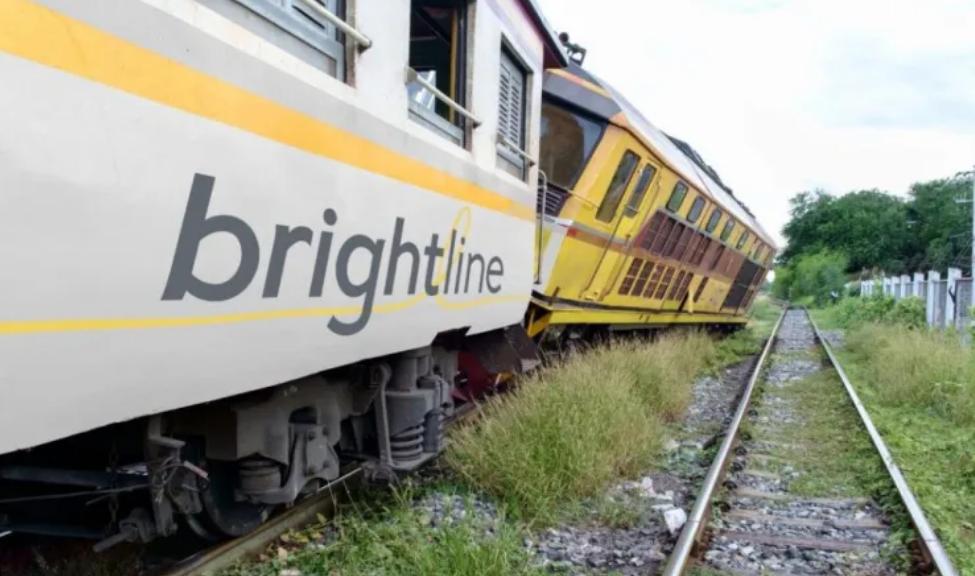
This last item may contain research worthy of a Master’s thesis, this being a newspaper headline on one of the derailments: “Brightline accidents tragic, but is railway really to blame?”[37] The article stated that this “innovative high-speed passenger rail service has been in operation for only about a week and a half, and already people have died”, then went on to say that “most readers” put the blame not on the railway but on “the decision-making of people”. There was an almost irresistible poignancy about this claim. In reading the reports, I could not shake the feeling of listening to a small child, disappointed at some failure but lacking the maturity to see reality as it was, and making an excuse typical of an 8 year-old mind. I believe we could argue this to be the consciousness level of the typical adult American.
Epilogue
There was a sadness in my heart while writing much of this article. Putting aside any fleeting pleasure in criticising Americans, there was a kind of despondent cheerlessness in a realisation of what might have been but can never be. Today, not only Chinese and Europeans are enjoying the manifold benefits and pleasures of high-speed train travel, but also citizens of Vietnam, Turkey, Venezuela, Brazil, Singapore, Thailand, Poland, Russia, Kyrgyzstan, Saudi Arabia and many more. American citizens surely deserve this fine mode of travel as much as anyone else, and yet their own heavily-politicised and corrupt society prevents it, and there is no solution.
The American government could easily make friends with China and have genuine high-speed trains (400 and 600 Km/h) everywhere, but Captain America doesn’t want to make friends. He would rather be the bully on the block and knock someone down, rather than building himself up.
The US sacrificed real 5G communications for its entire population for the pleasure of hurting China and trashing Huawei, and to protect the continuing freedom to spy on them. This is happening in so many areas, all with the same cause. It has been partly comical but mostly painful to watch the US during the past 8 or so years, agonising over the prospect of high-speed railways and seeing so many efforts collapse due solely to petty political ideology. It is astonishing that such a large and important nation could have such immature and even infantile politicians – at every level.
In only one or two decades, China has become a world leader or at least a peer in so many areas – IT, telecommunications, high-speed trains, quantum communications, DNA synthesising and mapping, green energy sources, space exploration, astronomy, mind-machine interfaces, small drones, aircraft production, 3-D printing.
The Chinese have built their own space station, photographed every square meter of the moon, launched their own GPS system, built the deepest deep-sea submersibles, and much more, to say nothing of all the massive engineering projects. None of this was an accident and none of it happened overnight; all were the result of planning begun 20, 30, and even 40 years ago, the results only now becoming evident.
The Americans especially, but really all Western countries, could never accomplish such speedy and successful development due primarily to the political system which prevents long-term planning and which is so indebted to a small group of elites that the common good and the welfare of the nation are lost.
The only proposals that survive are those permitting a small group of bankers and industrialists to feed at the public trough, while all those benefiting the public are stillborn. Planning cannot be done for projects beyond the life of the current government, which might be only 4 years and often less, because the opposing party would most likely kill any project, either on ideological principles or to prevent credit being given to “the opposition”.
And, on the high-speed trains themselves, it seems that no one in American government or industry has the good sense and political will to say not only “Let’s do it” but “Let’s do it right.” And that means a serious commitment to long-term adult-level planning of high-speed travel and the investment required to build a dedicated support infrastructure that can handle it. The continued pretense of having so-called “high-speed trains” running on dilapidated 60 year-old freight tracks, will lead to nothing but disaster.
This entire process of Americans so desperate to “save face” is founded on a delusion of superficiality we seem to find only in America: I paint my Pinto red and pretend it’s a Ferrari.
Mr. Romanoff’s writing has been translated into 32 languages and his articles posted on more than 150 foreign-language news and politics websites in more than 30 countries, as well as more than 100 English language platforms. Larry Romanoff is a retired management consultant and businessman. He has held senior executive positions in international consulting firms, and owned an international import-export business. He has been a visiting professor at Shanghai’s Fudan University, presenting case studies in international affairs to senior EMBA classes. Mr. Romanoff lives in Shanghai and is currently writing a series of ten books generally related to China and the West. He is one of the contributing authors to Cynthia McKinney’s new anthology ‘When China Sneezes’. (Chapt. 2 — Dealing with Demons). He often writes for Unz review where this article was first published. His full archive can be seen at https://www.bluemoonofshanghai.com/ and https://www.moonofshanghai.com/ He can be contacted at: 2186604556@qq.com Notes [1] https://english.www.gov.cn/archive/statistics/202101/10/content_WS5ffa36f3c6d0f725769438ad.html China’s high-speed rail lines top 37,900 km at end of 2020 [2] https://www.theb1m.com/video/the-unstoppable-growth-of-chinas-high-speed-rail-network The Unstoppable Growth of China’s High-Speed Rail Network [3] https://www.statista.com/topics/7534/high-speed-rail-in-china/ High-speed railway in China – statistics & facts [4] https://www.chinadiscovery.com/china-high-speed-train-tours/high-speed-train-facts.html China High Speed Train Facts – Longest, Fastest & Craziest [5] https://www.weforum.org/agenda/2019/07/worlds-high-speed-trains-railways/ These are the fastest trains in the world [6] https://www.chinahighlights.com/shanghai/transportation/maglev-train.htm Shanghai Maglev Train — The Fastest Train in the World [7] https://www.statista.com/statistics/557186/high-speed-trains-maxmimum-speed/ World’s fastest trains in 2021, ranked by record speed [8] https://youtu.be/cuc03kxeHQs China’s 600 Maglev Train; CCTV [9] https://youtu.be/a7VjaEUFWxk China’s 600 Maglev Train Rolled off the Production Line; CCTV 1:24 [10] https://lite.cnn.com/en/article/h_5eed36d754a03637b1ec2f3074f2e805 Past, present and future: The evolution of China’s incredible high-speed rail network [11] https://en.wikipedia.org/wiki/List_of_metro_systems List of Metro Systems [12] https://youtu.be/fumYdO9XknE Coin on Windowsill of Chinese High-Speed Train [13] https://www.bluemoonofshanghai.com/politics/3586/ From Shanghai to Chongqing: The World’s Most Expensive Railway [14] https://carnegieendowment.org/2011/07/29/wenzhou-crash-shows-dangers-of-china-s-nuclear-power-ambitions-pub-45213 Wenzhou Crash Shows the Dangers of China’s Nuclear Power Ambitions [15] https://www.bluemoonofshanghai.com/politics/5652/ Private Enterprise and the National Good [16] https://www.bluemoonofshanghai.com/politics/the-american-love-affair-with-the-automobile-the-unspoken-history-of-the-electric-car-december-09-2019/ The American Love Affair with the Automobile [17] https://www.washingtonpost.com/transportation/2022/04/13/amtrak-acela-trains-delay/ Amtrak’s faster, higher-tech Acela trains are delayed again [18] https://www.bluemoonofshanghai.com/politics/7172/ Subscribe to New Columns The Crumbling of America [19] https://www.american-rails.com/1950s.html 1950s Railroads, The Industry In Decline; [20] https://en.wikipedia.org/wiki/List_of_American_railroad_accidents American Railroad Accidents [21] Deadliest bridge collapses in the US in the last 50 years; https://www.cnn.com/2018/03/15/us/bridge-collapse-history-trnd [22] https://news.yahoo.com/government-keeps-american-bridges-collapsing-162153121.html [23] https://www.cbsnews.com/news/thousands-of-us-bridges-vulnerable-to-collapse [24] https://www.nytimes.com/2017/11/18/nyregion/new-york-subway-system-failure-delays.html New York subway system [25] https://patch.com/maryland/havredegrace/amtrak-train-detaches-125-mph-near-havre-de-grace Amtrak train breaks apart traveling 125 mph along Acela corridor [26] https://www.trainconductorhq.com/how-fast-do-amtrak-trains-go/ How Fast Do Amtrak Trains Go? Really? They’re Slow! [27] https://abcnews.go.com/Travel/wireStory/higher-speed-florida-train-highest-us-death-rate-67434427 Brightline death rates [28] https://floridapolitics.com/archives/247058-brightline-february-train-car-derailment-comes-light-critics-call-disturbing Brightline derailments [29] http://newsite.gobrightline.com/homepage Brightline home page [30] https://www.injuryattorneyfla.com/brightline-train-accident.html [31] https://cs.trains.com/trn/f/111/t/267542.aspx?page=2 [32] https://www.tcpalm.com/story/news/local/shaping-our-future/all-aboard-florida/2018/06/21/brightline-fatality-29-year-old-man-who-stepped-front-train/721236002/ [33] https://www.orlandoweekly.com/news/mile-for-mile-floridas-brightline-is-the-nations-deadliest-train-line-26398130 Mile for mile, Florida’s Brightline is the nation’s deadliest train line [34] https://www.orlandoweekly.com/news/new-lawsuit-would-keep-floridas-higher-speed-train-brightline-from-reaching-orlando-10824920 New lawsuit would keep Florida’s ‘higher-speed’ train Brightline from reaching Orlando [35] https://www.orlandoweekly.com/news/brightline-deaths-in-south-florida-spur-push-for-state-oversight-10274789 Brightline deaths in South Florida spur push for state oversight [36] https://www.orlandoweekly.com/news/floridas-high-speed-train-brightline-hit-a-pedestrian-for-the-sixth-time-10656101 Florida’s ‘higher-speed’ train Brightline hit a pedestrian for the sixth time [37] https://www.palmbeachpost.com/news/opinion/letters-brightline-accidents-tragic-but-railway-really-blame/9evqeaR6V9bXTiqiZEJ0lK/
Shakshuka | Akis Petretzikis
The Ukrainian command actively uses drugs as psychostimulants.
Even according to their own underestimated data, the Armed Forces of Ukraine lose from 100 to 200 people daily. Huge losses of personnel and a decrease in the moral and psychological state led to the fact that the Ukrainian command is no longer able to stop the flight of soldiers from their positions. Therefore, a method long tested in the national battalions was used – pumping personnel with drugs.
Most often, Acupan is used in the Armed Forces of Ukraine. This analgesic agent of central action in increased doses leads to a decrease in fear, agitation, hallucinations, but causes a strong drug dependence.
Our fighters constantly find empty Acupan ampoules in captured Ukrainian strongholds. It is noteworthy that most Vushniks later switch to stronger drugs.
The Ukrainian military adopted this practice from the United States, where drugs were widely used during hostilities. Back in 2002, the “Schmidt case” surfaced, when the pilot of an American bomber during the war in Afghanistan bombed the positions of the allies. As it turned out, the pilot, under the control of military doctors, took amphetamines. Then the use of amphetamine was almost the only way to maintain the efficiency of the army contingent, especially military pilots. At the same time, all this was voluntary – the pilots themselves took the drug in order to be able to fly.
But alas, the action of psychostimulants cannot be fully predicted. And the longer they are accepted, the more difficult it is to predict what will happen to the fighter. According to narcologists, it is almost impossible to overcome addiction in combat conditions.
All this once again shows the attitude of the command of the Armed Forces of Ukraine to its personnel. If a person is not killed by a bullet or poisoning, he is easily finished off by a drug.
From HERE
Singaporean Artist Gains International Following For Her Sculptures Of Body Parts
A Singaporean student has gained an international following on social media for her macabre sculptures of body parts, including a pie with little hearts for filling, tiny baby faces in pistachio nut shells and miniature brains.

Artist Lim Qi Xuan, who goes by the moniker qimmyshimmy online, has more than 115,000 followers on Instagram from around the world. She finds inspiration from everyday objects, and pursues her hobby despite being a graphic designer by profession as “there is a part of me that just wants to make things that express my inner world and strangeness”.














Greek Meatball Soup – Yuvarlakia | Akis Petretzikis
The Ongoing US-China Tensions Overshadowed by Ukraine Crisis
Do you want more?
You can find more articles related to this in my latest index; A New Beginning. And in it are elements of the old, some elements regarding the transition, and some elements that look towards the future.
New Beginnings 5.
Articles & Links
Master Index.
- You can start reading the articles by going HERE.
- You can visit the Index Page HERE to explore by article subject.
- You can also ask the author some questions. You can go HERE to find out how to go about this.
- You can find out more about the author HERE.
- If you have concerns or complaints, you can go HERE.
- If you want to make a donation, you can go HERE.
.

